LO1.Analyse the impact and influence which the macro environment
VerifiedAdded on 2020/12/31
|19
|5748
|443
AI Summary
Contribute Materials
Your contribution can guide someone’s learning journey. Share your
documents today.
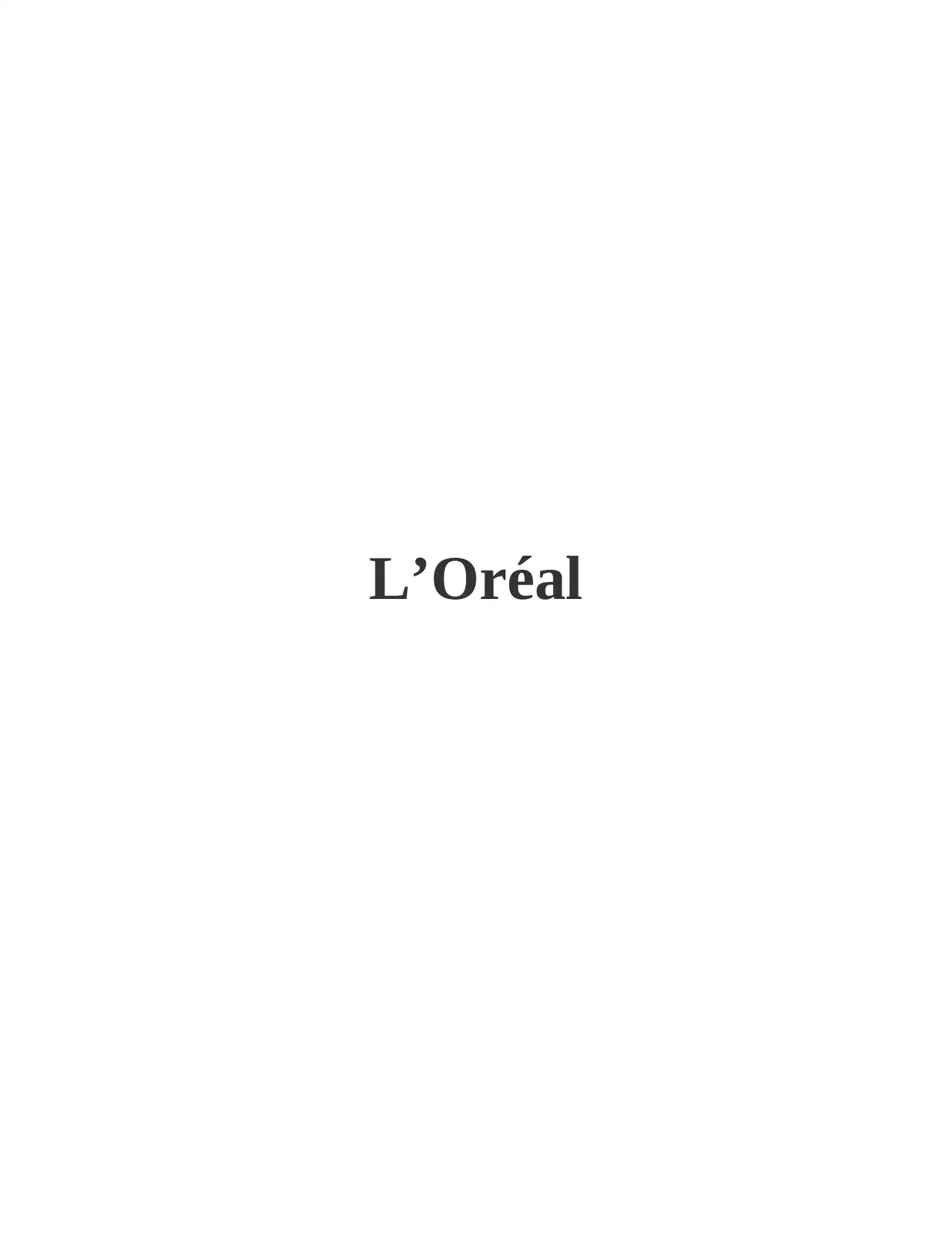
L’Oréal
Secure Best Marks with AI Grader
Need help grading? Try our AI Grader for instant feedback on your assignments.
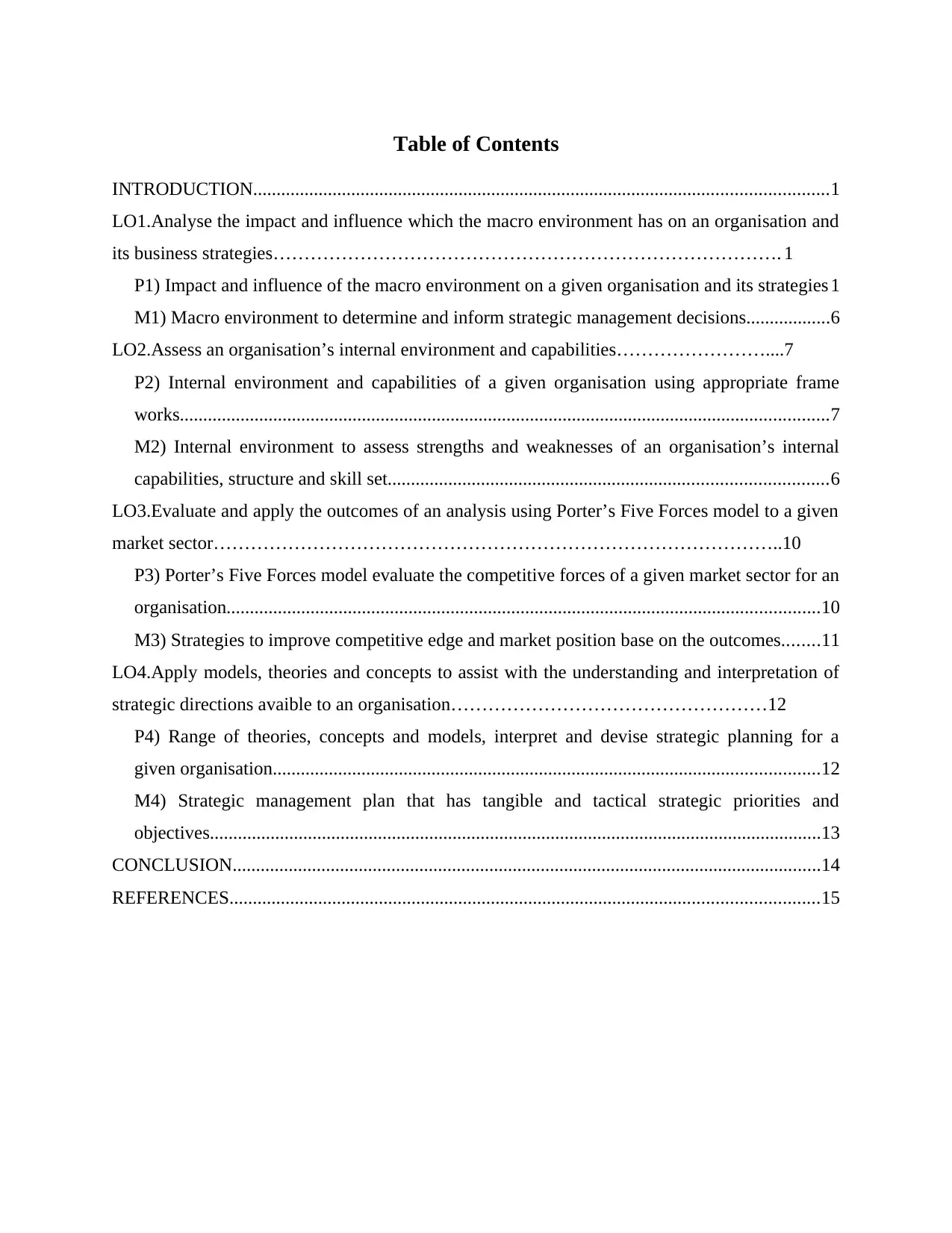
Table of Contents
INTRODUCTION...........................................................................................................................1
LO1.Analyse the impact and influence which the macro environment has on an organisation and
its business strategies………………………………………………………………………. 1
P1) Impact and influence of the macro environment on a given organisation and its strategies 1
M1) Macro environment to determine and inform strategic management decisions..................6
LO2.Assess an organisation’s internal environment and capabilities……………………....7
P2) Internal environment and capabilities of a given organisation using appropriate frame
works...........................................................................................................................................7
M2) Internal environment to assess strengths and weaknesses of an organisation’s internal
capabilities, structure and skill set..............................................................................................6
LO3.Evaluate and apply the outcomes of an analysis using Porter’s Five Forces model to a given
market sector………………………………………………………………………………..10
P3) Porter’s Five Forces model evaluate the competitive forces of a given market sector for an
organisation...............................................................................................................................10
M3) Strategies to improve competitive edge and market position base on the outcomes........11
LO4.Apply models, theories and concepts to assist with the understanding and interpretation of
strategic directions avaible to an organisation……………………………………………12
P4) Range of theories, concepts and models, interpret and devise strategic planning for a
given organisation.....................................................................................................................12
M4) Strategic management plan that has tangible and tactical strategic priorities and
objectives...................................................................................................................................13
CONCLUSION..............................................................................................................................14
REFERENCES..............................................................................................................................15
INTRODUCTION...........................................................................................................................1
LO1.Analyse the impact and influence which the macro environment has on an organisation and
its business strategies………………………………………………………………………. 1
P1) Impact and influence of the macro environment on a given organisation and its strategies 1
M1) Macro environment to determine and inform strategic management decisions..................6
LO2.Assess an organisation’s internal environment and capabilities……………………....7
P2) Internal environment and capabilities of a given organisation using appropriate frame
works...........................................................................................................................................7
M2) Internal environment to assess strengths and weaknesses of an organisation’s internal
capabilities, structure and skill set..............................................................................................6
LO3.Evaluate and apply the outcomes of an analysis using Porter’s Five Forces model to a given
market sector………………………………………………………………………………..10
P3) Porter’s Five Forces model evaluate the competitive forces of a given market sector for an
organisation...............................................................................................................................10
M3) Strategies to improve competitive edge and market position base on the outcomes........11
LO4.Apply models, theories and concepts to assist with the understanding and interpretation of
strategic directions avaible to an organisation……………………………………………12
P4) Range of theories, concepts and models, interpret and devise strategic planning for a
given organisation.....................................................................................................................12
M4) Strategic management plan that has tangible and tactical strategic priorities and
objectives...................................................................................................................................13
CONCLUSION..............................................................................................................................14
REFERENCES..............................................................................................................................15
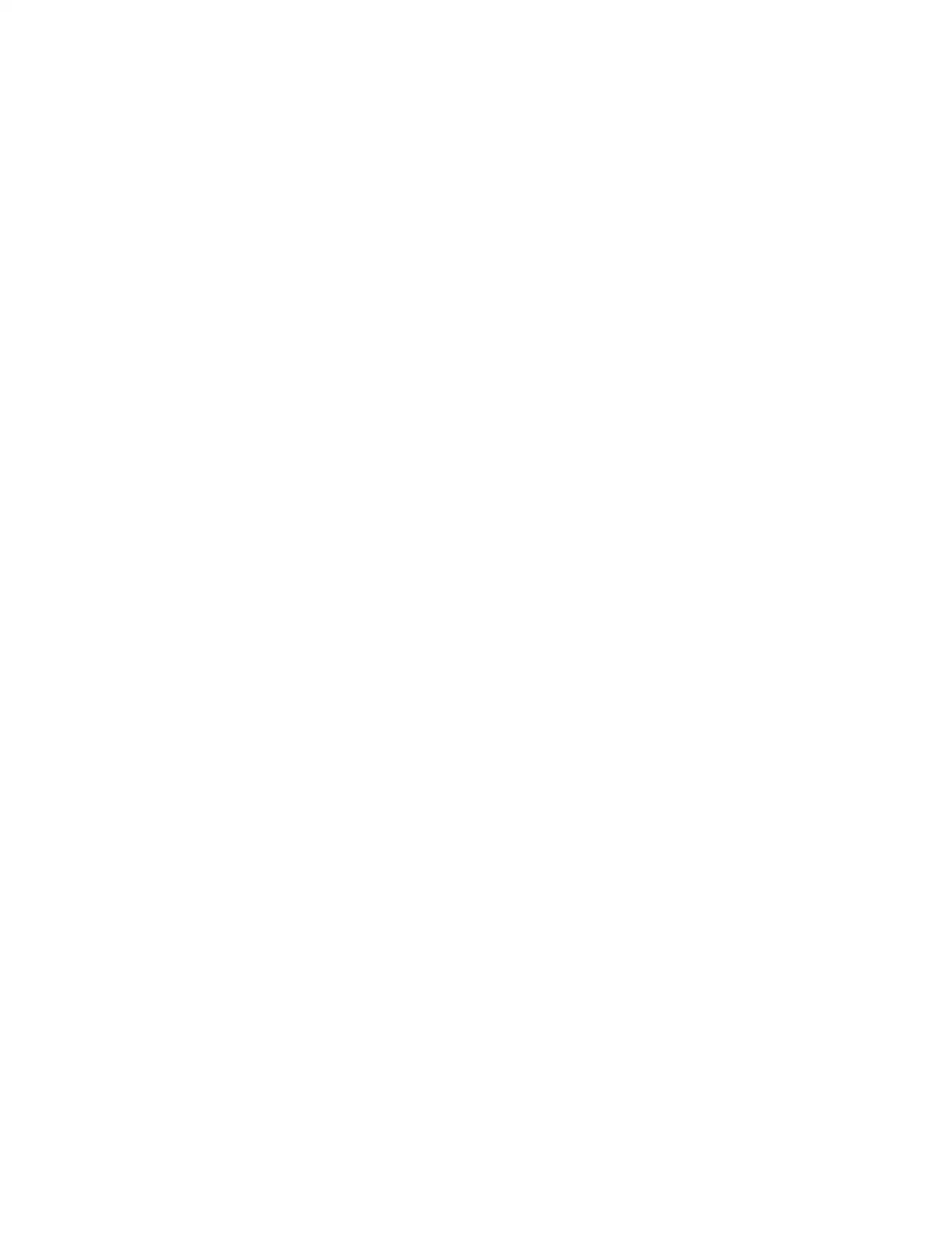
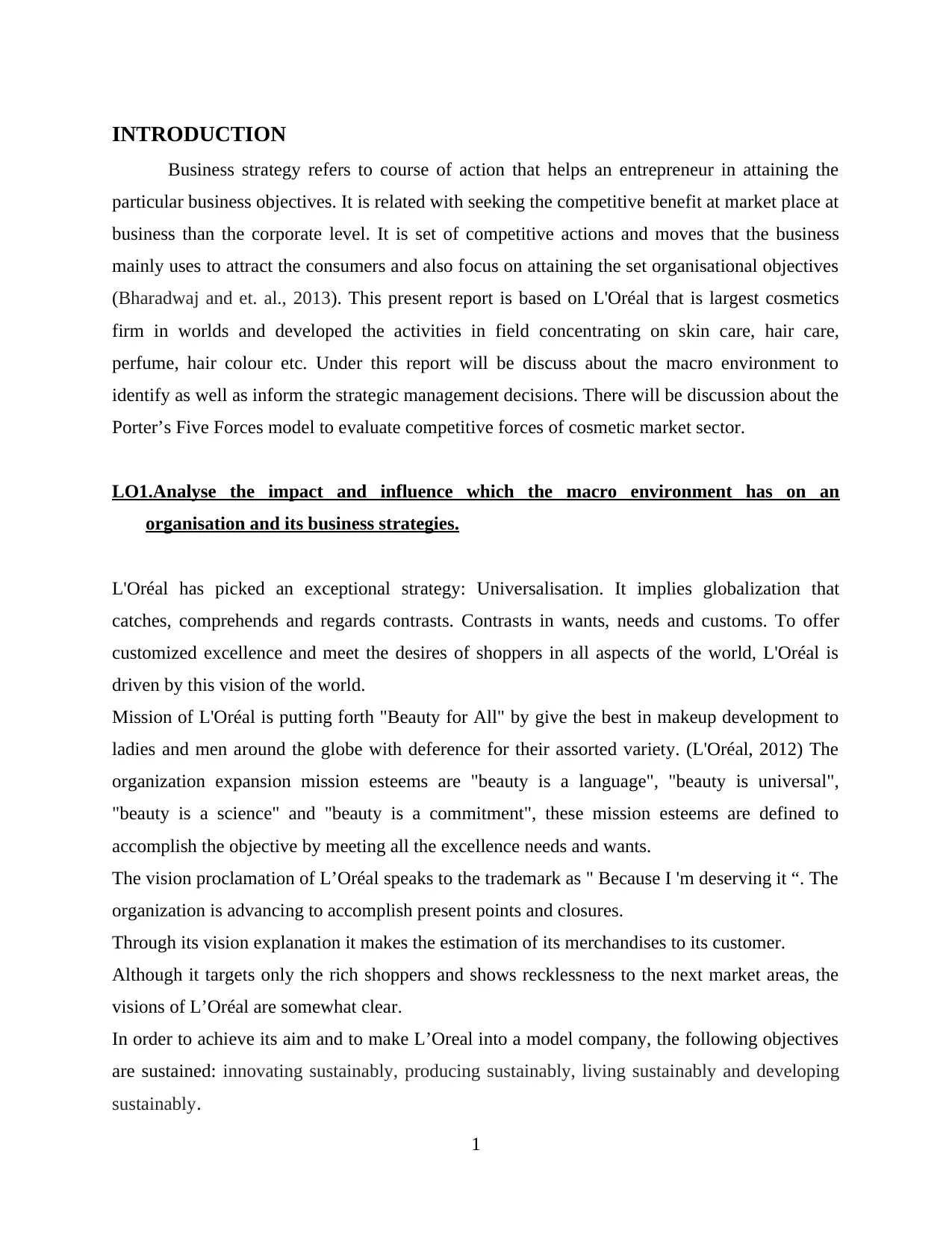
INTRODUCTION
Business strategy refers to course of action that helps an entrepreneur in attaining the
particular business objectives. It is related with seeking the competitive benefit at market place at
business than the corporate level. It is set of competitive actions and moves that the business
mainly uses to attract the consumers and also focus on attaining the set organisational objectives
(Bharadwaj and et. al., 2013). This present report is based on L'Oréal that is largest cosmetics
firm in worlds and developed the activities in field concentrating on skin care, hair care,
perfume, hair colour etc. Under this report will be discuss about the macro environment to
identify as well as inform the strategic management decisions. There will be discussion about the
Porter’s Five Forces model to evaluate competitive forces of cosmetic market sector.
LO1.Analyse the impact and influence which the macro environment has on an
organisation and its business strategies.
L'Oréal has picked an exceptional strategy: Universalisation. It implies globalization that
catches, comprehends and regards contrasts. Contrasts in wants, needs and customs. To offer
customized excellence and meet the desires of shoppers in all aspects of the world, L'Oréal is
driven by this vision of the world.
Mission of L'Oréal is putting forth "Beauty for All" by give the best in makeup development to
ladies and men around the globe with deference for their assorted variety. (L'Oréal, 2012) The
organization expansion mission esteems are "beauty is a language", "beauty is universal",
"beauty is a science" and "beauty is a commitment", these mission esteems are defined to
accomplish the objective by meeting all the excellence needs and wants.
The vision proclamation of L’Oréal speaks to the trademark as " Because I 'm deserving it “. The
organization is advancing to accomplish present points and closures.
Through its vision explanation it makes the estimation of its merchandises to its customer.
Although it targets only the rich shoppers and shows recklessness to the next market areas, the
visions of L’Oréal are somewhat clear.
In order to achieve its aim and to make L’Oreal into a model company, the following objectives
are sustained: innovating sustainably, producing sustainably, living sustainably and developing
sustainably.
1
Business strategy refers to course of action that helps an entrepreneur in attaining the
particular business objectives. It is related with seeking the competitive benefit at market place at
business than the corporate level. It is set of competitive actions and moves that the business
mainly uses to attract the consumers and also focus on attaining the set organisational objectives
(Bharadwaj and et. al., 2013). This present report is based on L'Oréal that is largest cosmetics
firm in worlds and developed the activities in field concentrating on skin care, hair care,
perfume, hair colour etc. Under this report will be discuss about the macro environment to
identify as well as inform the strategic management decisions. There will be discussion about the
Porter’s Five Forces model to evaluate competitive forces of cosmetic market sector.
LO1.Analyse the impact and influence which the macro environment has on an
organisation and its business strategies.
L'Oréal has picked an exceptional strategy: Universalisation. It implies globalization that
catches, comprehends and regards contrasts. Contrasts in wants, needs and customs. To offer
customized excellence and meet the desires of shoppers in all aspects of the world, L'Oréal is
driven by this vision of the world.
Mission of L'Oréal is putting forth "Beauty for All" by give the best in makeup development to
ladies and men around the globe with deference for their assorted variety. (L'Oréal, 2012) The
organization expansion mission esteems are "beauty is a language", "beauty is universal",
"beauty is a science" and "beauty is a commitment", these mission esteems are defined to
accomplish the objective by meeting all the excellence needs and wants.
The vision proclamation of L’Oréal speaks to the trademark as " Because I 'm deserving it “. The
organization is advancing to accomplish present points and closures.
Through its vision explanation it makes the estimation of its merchandises to its customer.
Although it targets only the rich shoppers and shows recklessness to the next market areas, the
visions of L’Oréal are somewhat clear.
In order to achieve its aim and to make L’Oreal into a model company, the following objectives
are sustained: innovating sustainably, producing sustainably, living sustainably and developing
sustainably.
1
Secure Best Marks with AI Grader
Need help grading? Try our AI Grader for instant feedback on your assignments.

As we all know, strategy can be defined in different ways. According to Kay (1993) the strategy
of an organisation is the match between its internal capabilities and its external relationships.
A more general definition can be as: the frame work which determines the scope and direction of
a company over a long period of time.
From my point of view, the role of strategy is to help organisations to achieve its goal thru their
well-planned objectives. Strategy can have its advantages and disadvantages:
Advantages Disadvantages
Better use of resources Can be limited
Forces organisations to look ahead Can be time consuming
Provides a direction Some unplanned opportunities may be
missed
In view of their diverse field of activation, companies are applying various strategic planning
techniques in order to achieve the businesses goal/goals.
Some of the strategic planning techniques are as listed below:
Forecasting – it can be defined as the predictions of market demand.
Goal planning - Strategy is primarily determinate by goals with regards to the chances
and threats that exist in the market.
Mission and vision - are central explanations of why you exist and where you are going.
Structured Decision Making - The utilization of a procedure for strategic decision
making, for example, steps that enable your whole association to give technique
recommendations an arrangement of prioritization and endorsements.
Capability analysis - Depicting your organisation as a lot of capacities and recognizing
holes that speak to a focused shortcoming or new abilities that speak to a potential
preferred standpoint.
SWOT - An evaluation of current strengths, weaknesses, threats and opportunities.
ETC
2
of an organisation is the match between its internal capabilities and its external relationships.
A more general definition can be as: the frame work which determines the scope and direction of
a company over a long period of time.
From my point of view, the role of strategy is to help organisations to achieve its goal thru their
well-planned objectives. Strategy can have its advantages and disadvantages:
Advantages Disadvantages
Better use of resources Can be limited
Forces organisations to look ahead Can be time consuming
Provides a direction Some unplanned opportunities may be
missed
In view of their diverse field of activation, companies are applying various strategic planning
techniques in order to achieve the businesses goal/goals.
Some of the strategic planning techniques are as listed below:
Forecasting – it can be defined as the predictions of market demand.
Goal planning - Strategy is primarily determinate by goals with regards to the chances
and threats that exist in the market.
Mission and vision - are central explanations of why you exist and where you are going.
Structured Decision Making - The utilization of a procedure for strategic decision
making, for example, steps that enable your whole association to give technique
recommendations an arrangement of prioritization and endorsements.
Capability analysis - Depicting your organisation as a lot of capacities and recognizing
holes that speak to a focused shortcoming or new abilities that speak to a potential
preferred standpoint.
SWOT - An evaluation of current strengths, weaknesses, threats and opportunities.
ETC
2
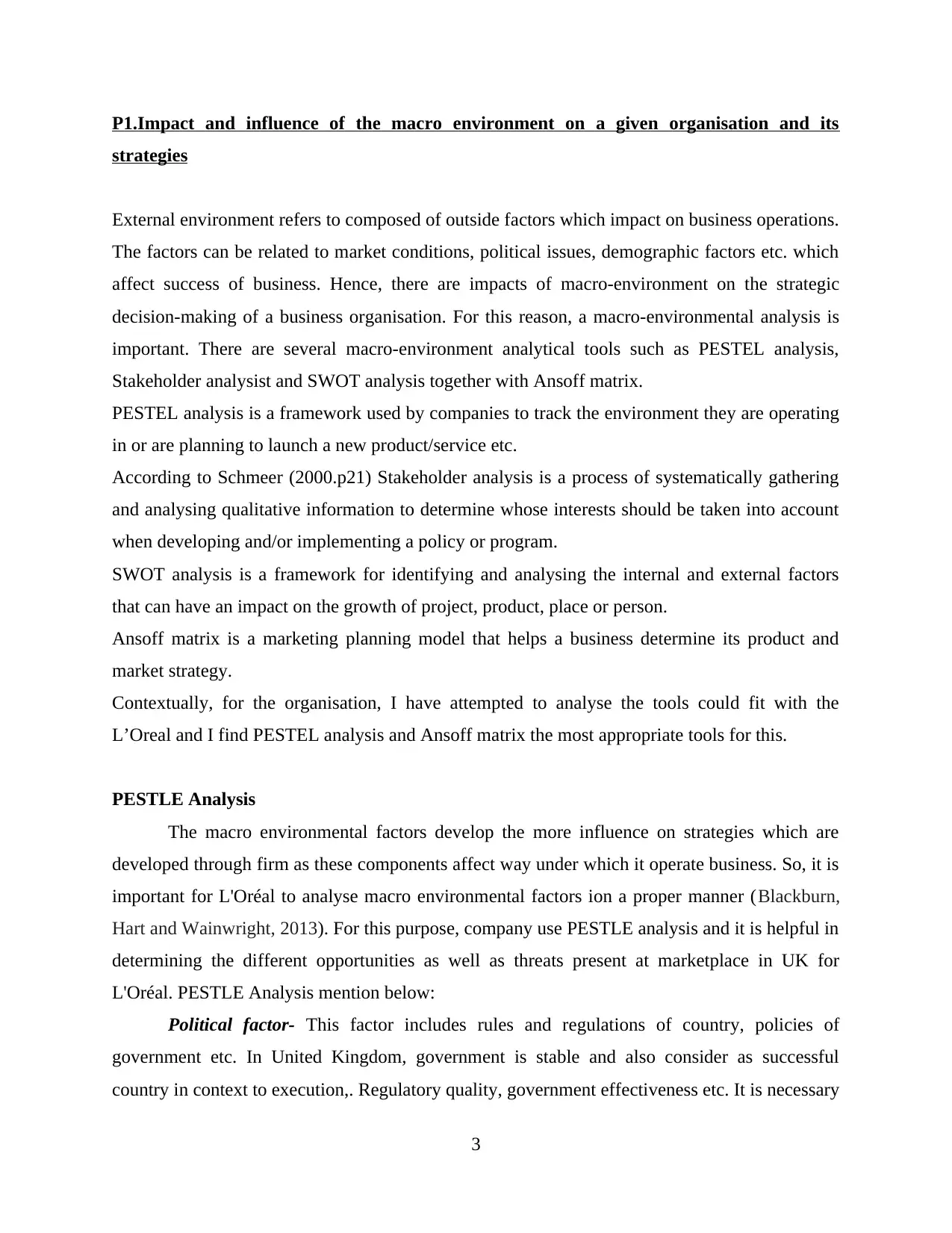
P1.Impact and influence of the macro environment on a given organisation and its
strategies
External environment refers to composed of outside factors which impact on business operations.
The factors can be related to market conditions, political issues, demographic factors etc. which
affect success of business. Hence, there are impacts of macro-environment on the strategic
decision-making of a business organisation. For this reason, a macro-environmental analysis is
important. There are several macro-environment analytical tools such as PESTEL analysis,
Stakeholder analysist and SWOT analysis together with Ansoff matrix.
PESTEL analysis is a framework used by companies to track the environment they are operating
in or are planning to launch a new product/service etc.
According to Schmeer (2000.p21) Stakeholder analysis is a process of systematically gathering
and analysing qualitative information to determine whose interests should be taken into account
when developing and/or implementing a policy or program.
SWOT analysis is a framework for identifying and analysing the internal and external factors
that can have an impact on the growth of project, product, place or person.
Ansoff matrix is a marketing planning model that helps a business determine its product and
market strategy.
Contextually, for the organisation, I have attempted to analyse the tools could fit with the
L’Oreal and I find PESTEL analysis and Ansoff matrix the most appropriate tools for this.
PESTLE Analysis
The macro environmental factors develop the more influence on strategies which are
developed through firm as these components affect way under which it operate business. So, it is
important for L'Oréal to analyse macro environmental factors ion a proper manner (Blackburn,
Hart and Wainwright, 2013). For this purpose, company use PESTLE analysis and it is helpful in
determining the different opportunities as well as threats present at marketplace in UK for
L'Oréal. PESTLE Analysis mention below:
Political factor- This factor includes rules and regulations of country, policies of
government etc. In United Kingdom, government is stable and also consider as successful
country in context to execution,. Regulatory quality, government effectiveness etc. It is necessary
3
strategies
External environment refers to composed of outside factors which impact on business operations.
The factors can be related to market conditions, political issues, demographic factors etc. which
affect success of business. Hence, there are impacts of macro-environment on the strategic
decision-making of a business organisation. For this reason, a macro-environmental analysis is
important. There are several macro-environment analytical tools such as PESTEL analysis,
Stakeholder analysist and SWOT analysis together with Ansoff matrix.
PESTEL analysis is a framework used by companies to track the environment they are operating
in or are planning to launch a new product/service etc.
According to Schmeer (2000.p21) Stakeholder analysis is a process of systematically gathering
and analysing qualitative information to determine whose interests should be taken into account
when developing and/or implementing a policy or program.
SWOT analysis is a framework for identifying and analysing the internal and external factors
that can have an impact on the growth of project, product, place or person.
Ansoff matrix is a marketing planning model that helps a business determine its product and
market strategy.
Contextually, for the organisation, I have attempted to analyse the tools could fit with the
L’Oreal and I find PESTEL analysis and Ansoff matrix the most appropriate tools for this.
PESTLE Analysis
The macro environmental factors develop the more influence on strategies which are
developed through firm as these components affect way under which it operate business. So, it is
important for L'Oréal to analyse macro environmental factors ion a proper manner (Blackburn,
Hart and Wainwright, 2013). For this purpose, company use PESTLE analysis and it is helpful in
determining the different opportunities as well as threats present at marketplace in UK for
L'Oréal. PESTLE Analysis mention below:
Political factor- This factor includes rules and regulations of country, policies of
government etc. In United Kingdom, government is stable and also consider as successful
country in context to execution,. Regulatory quality, government effectiveness etc. It is necessary
3
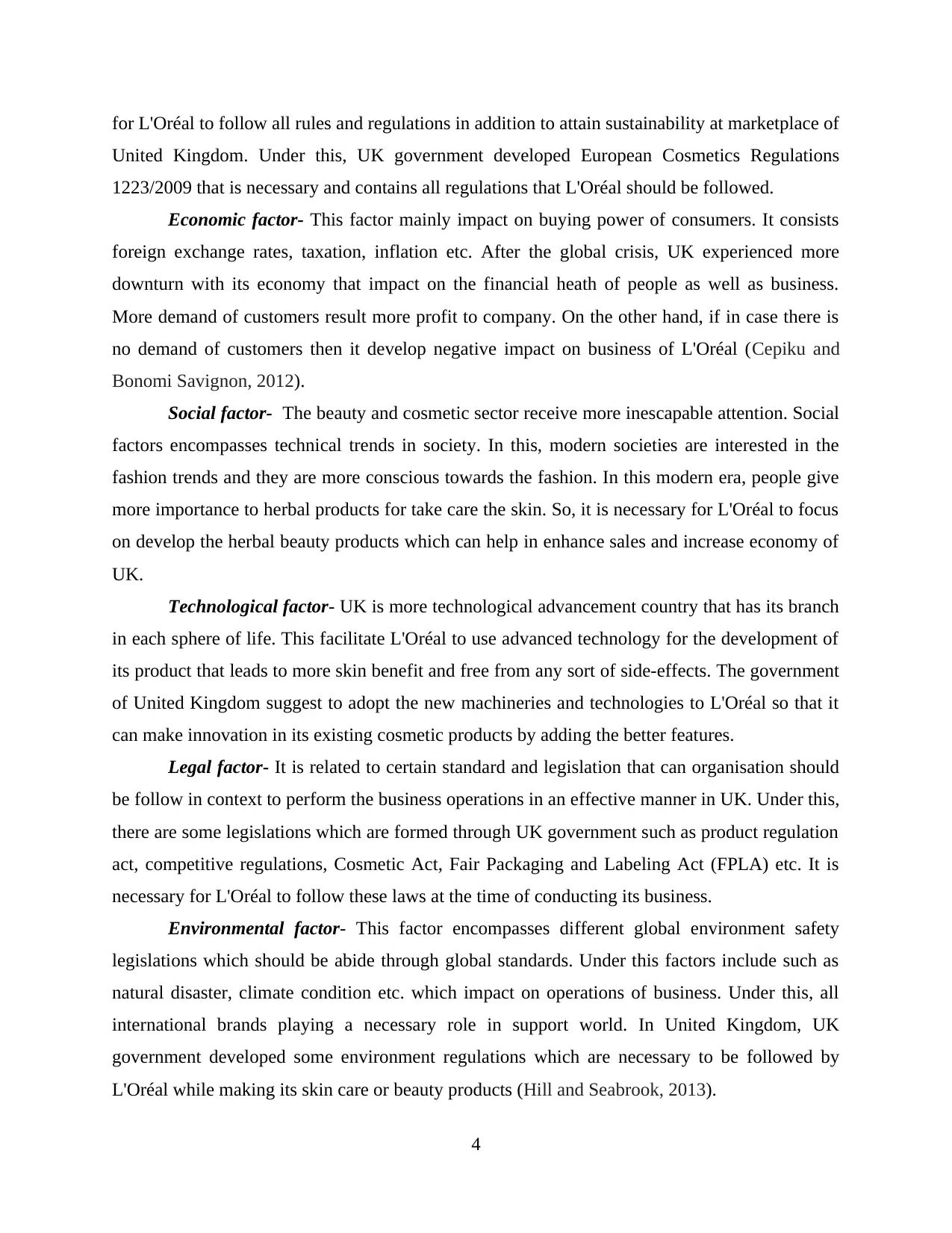
for L'Oréal to follow all rules and regulations in addition to attain sustainability at marketplace of
United Kingdom. Under this, UK government developed European Cosmetics Regulations
1223/2009 that is necessary and contains all regulations that L'Oréal should be followed.
Economic factor- This factor mainly impact on buying power of consumers. It consists
foreign exchange rates, taxation, inflation etc. After the global crisis, UK experienced more
downturn with its economy that impact on the financial heath of people as well as business.
More demand of customers result more profit to company. On the other hand, if in case there is
no demand of customers then it develop negative impact on business of L'Oréal (Cepiku and
Bonomi Savignon, 2012).
Social factor- The beauty and cosmetic sector receive more inescapable attention. Social
factors encompasses technical trends in society. In this, modern societies are interested in the
fashion trends and they are more conscious towards the fashion. In this modern era, people give
more importance to herbal products for take care the skin. So, it is necessary for L'Oréal to focus
on develop the herbal beauty products which can help in enhance sales and increase economy of
UK.
Technological factor- UK is more technological advancement country that has its branch
in each sphere of life. This facilitate L'Oréal to use advanced technology for the development of
its product that leads to more skin benefit and free from any sort of side-effects. The government
of United Kingdom suggest to adopt the new machineries and technologies to L'Oréal so that it
can make innovation in its existing cosmetic products by adding the better features.
Legal factor- It is related to certain standard and legislation that can organisation should
be follow in context to perform the business operations in an effective manner in UK. Under this,
there are some legislations which are formed through UK government such as product regulation
act, competitive regulations, Cosmetic Act, Fair Packaging and Labeling Act (FPLA) etc. It is
necessary for L'Oréal to follow these laws at the time of conducting its business.
Environmental factor- This factor encompasses different global environment safety
legislations which should be abide through global standards. Under this factors include such as
natural disaster, climate condition etc. which impact on operations of business. Under this, all
international brands playing a necessary role in support world. In United Kingdom, UK
government developed some environment regulations which are necessary to be followed by
L'Oréal while making its skin care or beauty products (Hill and Seabrook, 2013).
4
United Kingdom. Under this, UK government developed European Cosmetics Regulations
1223/2009 that is necessary and contains all regulations that L'Oréal should be followed.
Economic factor- This factor mainly impact on buying power of consumers. It consists
foreign exchange rates, taxation, inflation etc. After the global crisis, UK experienced more
downturn with its economy that impact on the financial heath of people as well as business.
More demand of customers result more profit to company. On the other hand, if in case there is
no demand of customers then it develop negative impact on business of L'Oréal (Cepiku and
Bonomi Savignon, 2012).
Social factor- The beauty and cosmetic sector receive more inescapable attention. Social
factors encompasses technical trends in society. In this, modern societies are interested in the
fashion trends and they are more conscious towards the fashion. In this modern era, people give
more importance to herbal products for take care the skin. So, it is necessary for L'Oréal to focus
on develop the herbal beauty products which can help in enhance sales and increase economy of
UK.
Technological factor- UK is more technological advancement country that has its branch
in each sphere of life. This facilitate L'Oréal to use advanced technology for the development of
its product that leads to more skin benefit and free from any sort of side-effects. The government
of United Kingdom suggest to adopt the new machineries and technologies to L'Oréal so that it
can make innovation in its existing cosmetic products by adding the better features.
Legal factor- It is related to certain standard and legislation that can organisation should
be follow in context to perform the business operations in an effective manner in UK. Under this,
there are some legislations which are formed through UK government such as product regulation
act, competitive regulations, Cosmetic Act, Fair Packaging and Labeling Act (FPLA) etc. It is
necessary for L'Oréal to follow these laws at the time of conducting its business.
Environmental factor- This factor encompasses different global environment safety
legislations which should be abide through global standards. Under this factors include such as
natural disaster, climate condition etc. which impact on operations of business. Under this, all
international brands playing a necessary role in support world. In United Kingdom, UK
government developed some environment regulations which are necessary to be followed by
L'Oréal while making its skin care or beauty products (Hill and Seabrook, 2013).
4
Paraphrase This Document
Need a fresh take? Get an instant paraphrase of this document with our AI Paraphraser
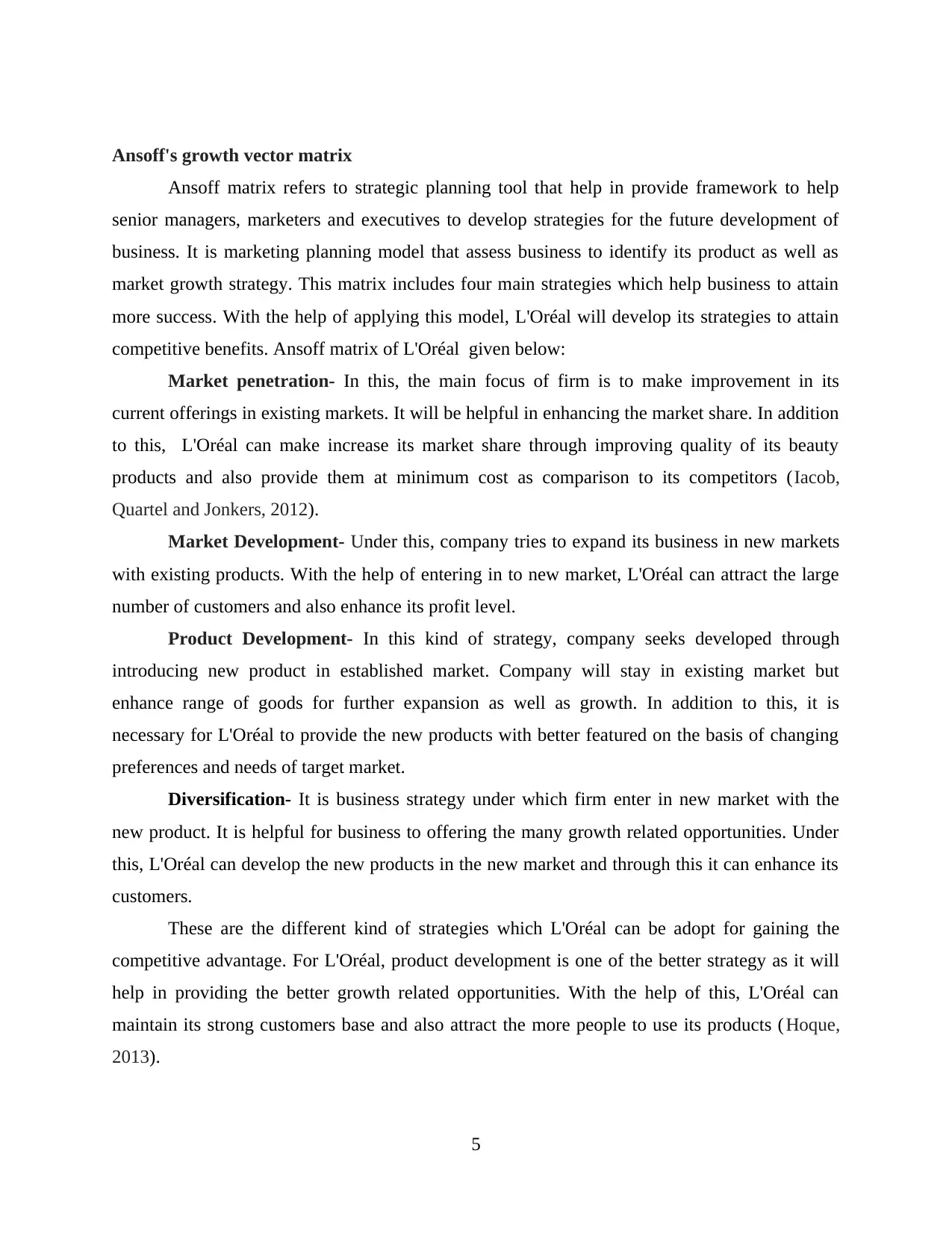
Ansoff's growth vector matrix
Ansoff matrix refers to strategic planning tool that help in provide framework to help
senior managers, marketers and executives to develop strategies for the future development of
business. It is marketing planning model that assess business to identify its product as well as
market growth strategy. This matrix includes four main strategies which help business to attain
more success. With the help of applying this model, L'Oréal will develop its strategies to attain
competitive benefits. Ansoff matrix of L'Oréal given below:
Market penetration- In this, the main focus of firm is to make improvement in its
current offerings in existing markets. It will be helpful in enhancing the market share. In addition
to this, L'Oréal can make increase its market share through improving quality of its beauty
products and also provide them at minimum cost as comparison to its competitors (Iacob,
Quartel and Jonkers, 2012).
Market Development- Under this, company tries to expand its business in new markets
with existing products. With the help of entering in to new market, L'Oréal can attract the large
number of customers and also enhance its profit level.
Product Development- In this kind of strategy, company seeks developed through
introducing new product in established market. Company will stay in existing market but
enhance range of goods for further expansion as well as growth. In addition to this, it is
necessary for L'Oréal to provide the new products with better featured on the basis of changing
preferences and needs of target market.
Diversification- It is business strategy under which firm enter in new market with the
new product. It is helpful for business to offering the many growth related opportunities. Under
this, L'Oréal can develop the new products in the new market and through this it can enhance its
customers.
These are the different kind of strategies which L'Oréal can be adopt for gaining the
competitive advantage. For L'Oréal, product development is one of the better strategy as it will
help in providing the better growth related opportunities. With the help of this, L'Oréal can
maintain its strong customers base and also attract the more people to use its products (Hoque,
2013).
5
Ansoff matrix refers to strategic planning tool that help in provide framework to help
senior managers, marketers and executives to develop strategies for the future development of
business. It is marketing planning model that assess business to identify its product as well as
market growth strategy. This matrix includes four main strategies which help business to attain
more success. With the help of applying this model, L'Oréal will develop its strategies to attain
competitive benefits. Ansoff matrix of L'Oréal given below:
Market penetration- In this, the main focus of firm is to make improvement in its
current offerings in existing markets. It will be helpful in enhancing the market share. In addition
to this, L'Oréal can make increase its market share through improving quality of its beauty
products and also provide them at minimum cost as comparison to its competitors (Iacob,
Quartel and Jonkers, 2012).
Market Development- Under this, company tries to expand its business in new markets
with existing products. With the help of entering in to new market, L'Oréal can attract the large
number of customers and also enhance its profit level.
Product Development- In this kind of strategy, company seeks developed through
introducing new product in established market. Company will stay in existing market but
enhance range of goods for further expansion as well as growth. In addition to this, it is
necessary for L'Oréal to provide the new products with better featured on the basis of changing
preferences and needs of target market.
Diversification- It is business strategy under which firm enter in new market with the
new product. It is helpful for business to offering the many growth related opportunities. Under
this, L'Oréal can develop the new products in the new market and through this it can enhance its
customers.
These are the different kind of strategies which L'Oréal can be adopt for gaining the
competitive advantage. For L'Oréal, product development is one of the better strategy as it will
help in providing the better growth related opportunities. With the help of this, L'Oréal can
maintain its strong customers base and also attract the more people to use its products (Hoque,
2013).
5
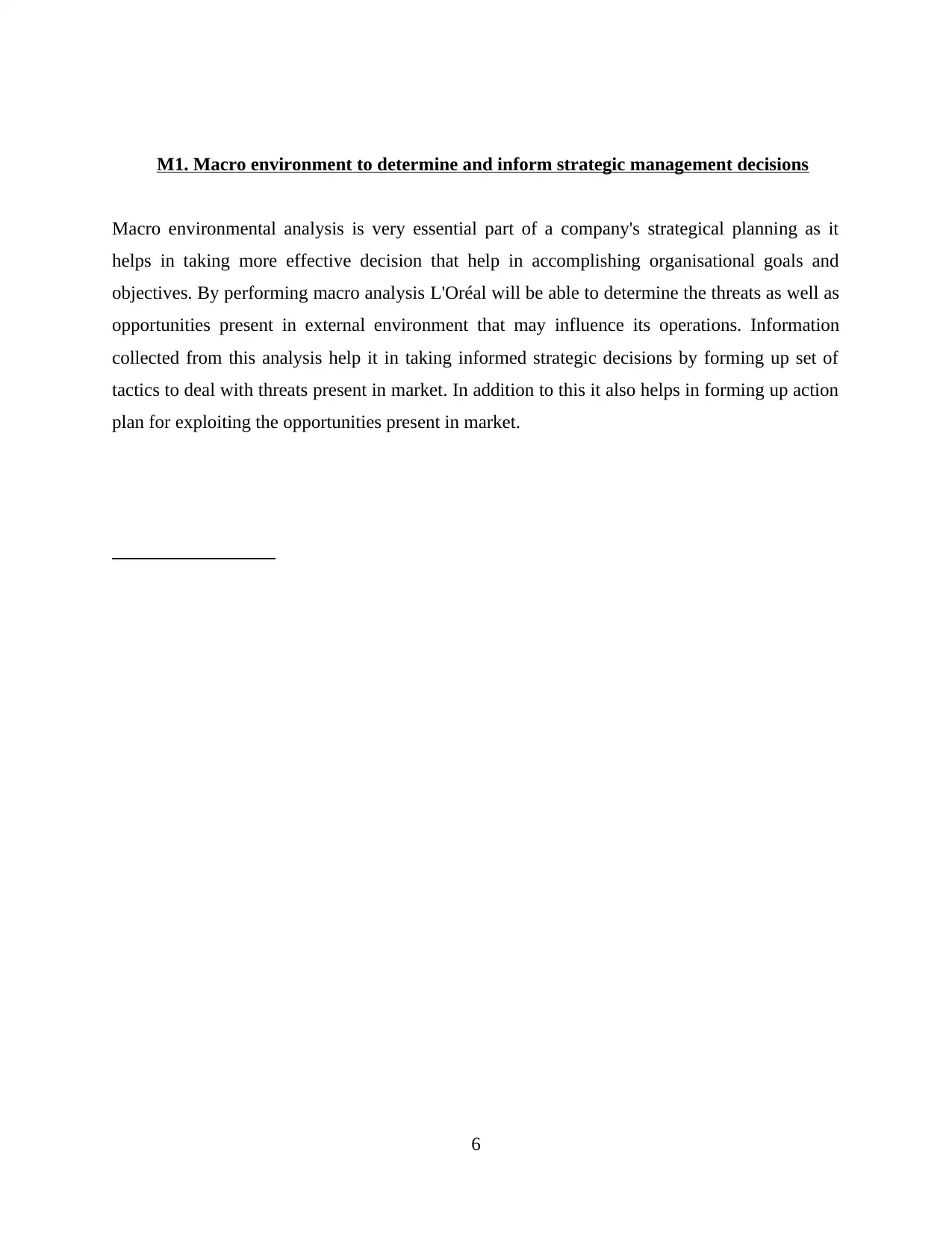
M1. Macro environment to determine and inform strategic management decisions
Macro environmental analysis is very essential part of a company's strategical planning as it
helps in taking more effective decision that help in accomplishing organisational goals and
objectives. By performing macro analysis L'Oréal will be able to determine the threats as well as
opportunities present in external environment that may influence its operations. Information
collected from this analysis help it in taking informed strategic decisions by forming up set of
tactics to deal with threats present in market. In addition to this it also helps in forming up action
plan for exploiting the opportunities present in market.
6
Macro environmental analysis is very essential part of a company's strategical planning as it
helps in taking more effective decision that help in accomplishing organisational goals and
objectives. By performing macro analysis L'Oréal will be able to determine the threats as well as
opportunities present in external environment that may influence its operations. Information
collected from this analysis help it in taking informed strategic decisions by forming up set of
tactics to deal with threats present in market. In addition to this it also helps in forming up action
plan for exploiting the opportunities present in market.
6
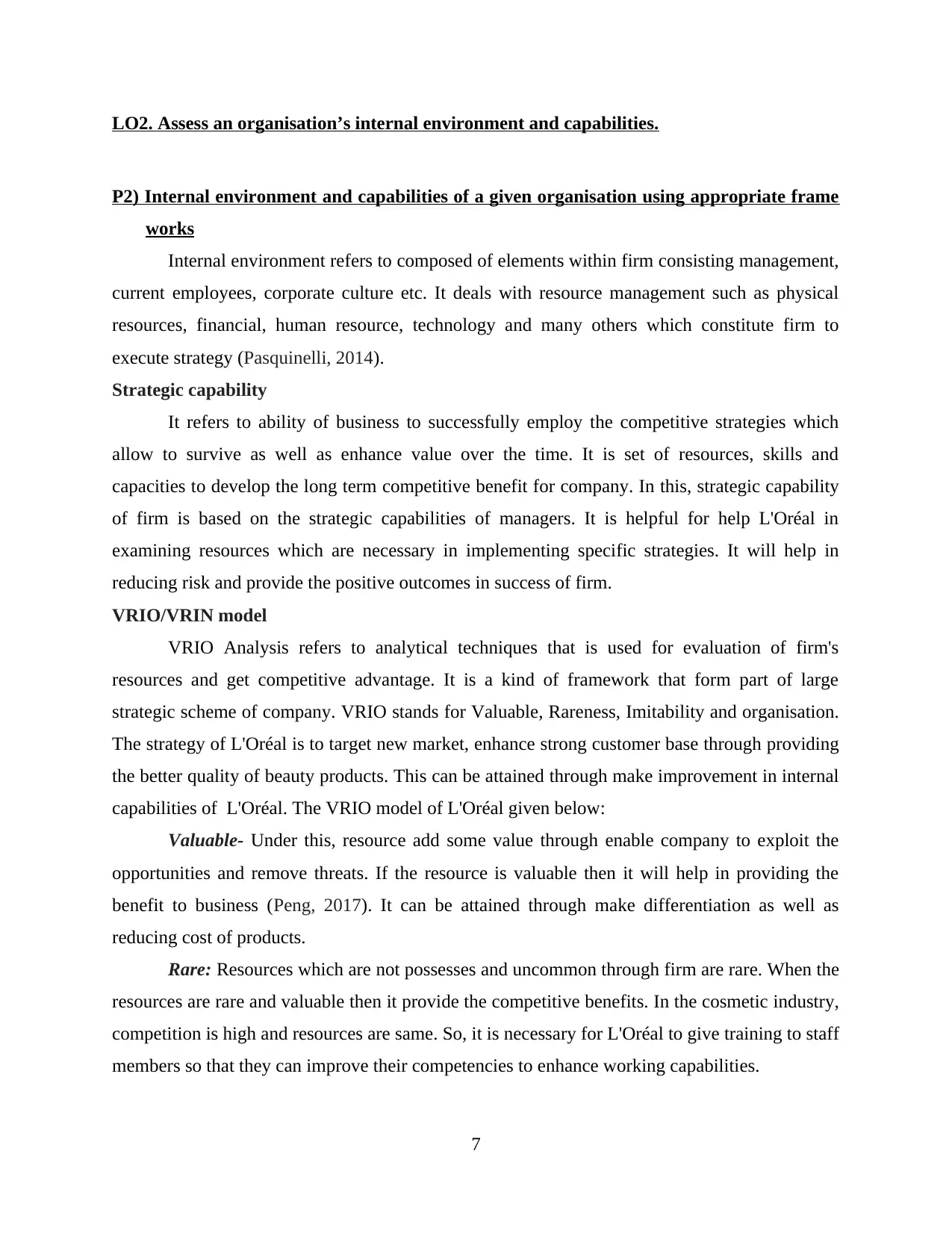
LO2. Assess an organisation’s internal environment and capabilities.
P2) Internal environment and capabilities of a given organisation using appropriate frame
works
Internal environment refers to composed of elements within firm consisting management,
current employees, corporate culture etc. It deals with resource management such as physical
resources, financial, human resource, technology and many others which constitute firm to
execute strategy (Pasquinelli, 2014).
Strategic capability
It refers to ability of business to successfully employ the competitive strategies which
allow to survive as well as enhance value over the time. It is set of resources, skills and
capacities to develop the long term competitive benefit for company. In this, strategic capability
of firm is based on the strategic capabilities of managers. It is helpful for help L'Oréal in
examining resources which are necessary in implementing specific strategies. It will help in
reducing risk and provide the positive outcomes in success of firm.
VRIO/VRIN model
VRIO Analysis refers to analytical techniques that is used for evaluation of firm's
resources and get competitive advantage. It is a kind of framework that form part of large
strategic scheme of company. VRIO stands for Valuable, Rareness, Imitability and organisation.
The strategy of L'Oréal is to target new market, enhance strong customer base through providing
the better quality of beauty products. This can be attained through make improvement in internal
capabilities of L'Oréal. The VRIO model of L'Oréal given below:
Valuable- Under this, resource add some value through enable company to exploit the
opportunities and remove threats. If the resource is valuable then it will help in providing the
benefit to business (Peng, 2017). It can be attained through make differentiation as well as
reducing cost of products.
Rare: Resources which are not possesses and uncommon through firm are rare. When the
resources are rare and valuable then it provide the competitive benefits. In the cosmetic industry,
competition is high and resources are same. So, it is necessary for L'Oréal to give training to staff
members so that they can improve their competencies to enhance working capabilities.
7
P2) Internal environment and capabilities of a given organisation using appropriate frame
works
Internal environment refers to composed of elements within firm consisting management,
current employees, corporate culture etc. It deals with resource management such as physical
resources, financial, human resource, technology and many others which constitute firm to
execute strategy (Pasquinelli, 2014).
Strategic capability
It refers to ability of business to successfully employ the competitive strategies which
allow to survive as well as enhance value over the time. It is set of resources, skills and
capacities to develop the long term competitive benefit for company. In this, strategic capability
of firm is based on the strategic capabilities of managers. It is helpful for help L'Oréal in
examining resources which are necessary in implementing specific strategies. It will help in
reducing risk and provide the positive outcomes in success of firm.
VRIO/VRIN model
VRIO Analysis refers to analytical techniques that is used for evaluation of firm's
resources and get competitive advantage. It is a kind of framework that form part of large
strategic scheme of company. VRIO stands for Valuable, Rareness, Imitability and organisation.
The strategy of L'Oréal is to target new market, enhance strong customer base through providing
the better quality of beauty products. This can be attained through make improvement in internal
capabilities of L'Oréal. The VRIO model of L'Oréal given below:
Valuable- Under this, resource add some value through enable company to exploit the
opportunities and remove threats. If the resource is valuable then it will help in providing the
benefit to business (Peng, 2017). It can be attained through make differentiation as well as
reducing cost of products.
Rare: Resources which are not possesses and uncommon through firm are rare. When the
resources are rare and valuable then it provide the competitive benefits. In the cosmetic industry,
competition is high and resources are same. So, it is necessary for L'Oréal to give training to staff
members so that they can improve their competencies to enhance working capabilities.
7
Secure Best Marks with AI Grader
Need help grading? Try our AI Grader for instant feedback on your assignments.
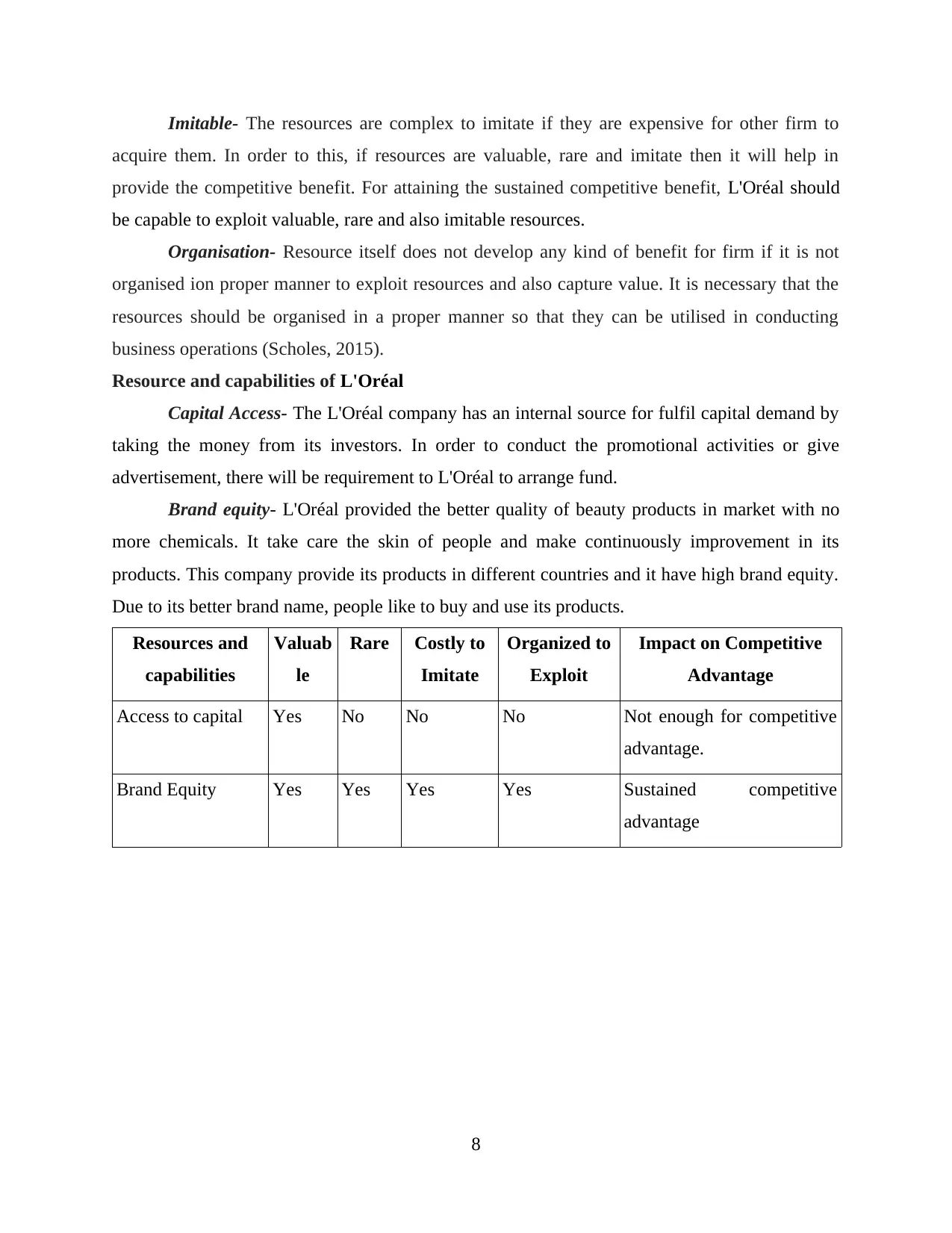
Imitable- The resources are complex to imitate if they are expensive for other firm to
acquire them. In order to this, if resources are valuable, rare and imitate then it will help in
provide the competitive benefit. For attaining the sustained competitive benefit, L'Oréal should
be capable to exploit valuable, rare and also imitable resources.
Organisation- Resource itself does not develop any kind of benefit for firm if it is not
organised ion proper manner to exploit resources and also capture value. It is necessary that the
resources should be organised in a proper manner so that they can be utilised in conducting
business operations (Scholes, 2015).
Resource and capabilities of L'Oréal
Capital Access- The L'Oréal company has an internal source for fulfil capital demand by
taking the money from its investors. In order to conduct the promotional activities or give
advertisement, there will be requirement to L'Oréal to arrange fund.
Brand equity- L'Oréal provided the better quality of beauty products in market with no
more chemicals. It take care the skin of people and make continuously improvement in its
products. This company provide its products in different countries and it have high brand equity.
Due to its better brand name, people like to buy and use its products.
Resources and
capabilities
Valuab
le
Rare Costly to
Imitate
Organized to
Exploit
Impact on Competitive
Advantage
Access to capital Yes No No No Not enough for competitive
advantage.
Brand Equity Yes Yes Yes Yes Sustained competitive
advantage
8
acquire them. In order to this, if resources are valuable, rare and imitate then it will help in
provide the competitive benefit. For attaining the sustained competitive benefit, L'Oréal should
be capable to exploit valuable, rare and also imitable resources.
Organisation- Resource itself does not develop any kind of benefit for firm if it is not
organised ion proper manner to exploit resources and also capture value. It is necessary that the
resources should be organised in a proper manner so that they can be utilised in conducting
business operations (Scholes, 2015).
Resource and capabilities of L'Oréal
Capital Access- The L'Oréal company has an internal source for fulfil capital demand by
taking the money from its investors. In order to conduct the promotional activities or give
advertisement, there will be requirement to L'Oréal to arrange fund.
Brand equity- L'Oréal provided the better quality of beauty products in market with no
more chemicals. It take care the skin of people and make continuously improvement in its
products. This company provide its products in different countries and it have high brand equity.
Due to its better brand name, people like to buy and use its products.
Resources and
capabilities
Valuab
le
Rare Costly to
Imitate
Organized to
Exploit
Impact on Competitive
Advantage
Access to capital Yes No No No Not enough for competitive
advantage.
Brand Equity Yes Yes Yes Yes Sustained competitive
advantage
8
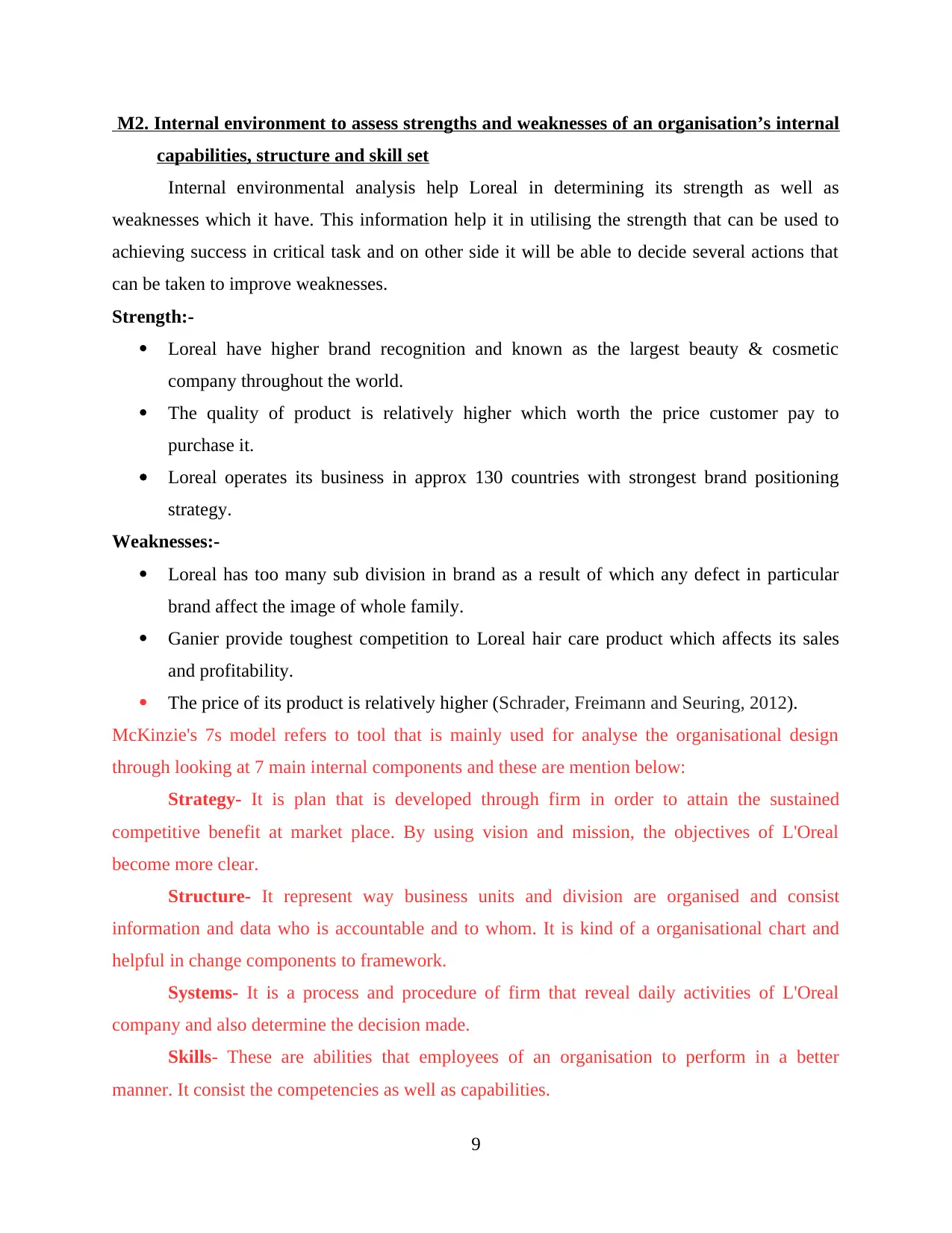
M2. Internal environment to assess strengths and weaknesses of an organisation’s internal
capabilities, structure and skill set
Internal environmental analysis help Loreal in determining its strength as well as
weaknesses which it have. This information help it in utilising the strength that can be used to
achieving success in critical task and on other side it will be able to decide several actions that
can be taken to improve weaknesses.
Strength:-
Loreal have higher brand recognition and known as the largest beauty & cosmetic
company throughout the world.
The quality of product is relatively higher which worth the price customer pay to
purchase it.
Loreal operates its business in approx 130 countries with strongest brand positioning
strategy.
Weaknesses:-
Loreal has too many sub division in brand as a result of which any defect in particular
brand affect the image of whole family.
Ganier provide toughest competition to Loreal hair care product which affects its sales
and profitability.
The price of its product is relatively higher (Schrader, Freimann and Seuring, 2012).
McKinzie's 7s model refers to tool that is mainly used for analyse the organisational design
through looking at 7 main internal components and these are mention below:
Strategy- It is plan that is developed through firm in order to attain the sustained
competitive benefit at market place. By using vision and mission, the objectives of L'Oreal
become more clear.
Structure- It represent way business units and division are organised and consist
information and data who is accountable and to whom. It is kind of a organisational chart and
helpful in change components to framework.
Systems- It is a process and procedure of firm that reveal daily activities of L'Oreal
company and also determine the decision made.
Skills- These are abilities that employees of an organisation to perform in a better
manner. It consist the competencies as well as capabilities.
9
capabilities, structure and skill set
Internal environmental analysis help Loreal in determining its strength as well as
weaknesses which it have. This information help it in utilising the strength that can be used to
achieving success in critical task and on other side it will be able to decide several actions that
can be taken to improve weaknesses.
Strength:-
Loreal have higher brand recognition and known as the largest beauty & cosmetic
company throughout the world.
The quality of product is relatively higher which worth the price customer pay to
purchase it.
Loreal operates its business in approx 130 countries with strongest brand positioning
strategy.
Weaknesses:-
Loreal has too many sub division in brand as a result of which any defect in particular
brand affect the image of whole family.
Ganier provide toughest competition to Loreal hair care product which affects its sales
and profitability.
The price of its product is relatively higher (Schrader, Freimann and Seuring, 2012).
McKinzie's 7s model refers to tool that is mainly used for analyse the organisational design
through looking at 7 main internal components and these are mention below:
Strategy- It is plan that is developed through firm in order to attain the sustained
competitive benefit at market place. By using vision and mission, the objectives of L'Oreal
become more clear.
Structure- It represent way business units and division are organised and consist
information and data who is accountable and to whom. It is kind of a organisational chart and
helpful in change components to framework.
Systems- It is a process and procedure of firm that reveal daily activities of L'Oreal
company and also determine the decision made.
Skills- These are abilities that employees of an organisation to perform in a better
manner. It consist the competencies as well as capabilities.
9

Staff- It is related with what kind and how many staff members will be required at
workplace and how they will be hire, trained and motivated.
Style- It represent way that L'Oreal firm is managed through top- level of managers and
in what manner they interact. On the other hand, management style of this company is leader.
Shared values- Under this, these are the standards as well as norms that guide the
behaviour of staff members along with company actions.
From the above discussion, it is necessary for a leader to pay attention towards mention
seven elements on regular basis. It will help L'Oreal company to attain the goals in an effective
manner.
LO3.Evaluate and apply the outcomes of an analysis using Porter’s Five
Forces model to a given market sector.
P3. Porter’s Five Forces model evaluate the competitive forces of a given market sector for
an organisation
Porter's Five Force model refers to framework for analysing the competition of business.
It is mainly use to analyse attractiveness, competition intensity and also profitability of a market
or an industry. It is based on the five forces that identify competitive intensity along with
attractiveness of the market. It helps to determine where the power lead in business situation.
The Porter's Five Forces is useful in understand strength of current competitive position of
company and strength of position that firm may look for move. In order to determine the
competitive position at market place, L'Oréal organisation use Porter's Five Forces model and it
is given below as above:
Bargaining Power of Customers- Mainly power lies with buyers as there are several
companies which produce the same kind of products. The bargaining power of consumers
measure power which customers have related to cost changes. Under this, consumers have the
respectable choice over whom they purchase products from (Spender, 2014). In this, bargaining
power of customer is high because of similar type of products are available at market place so
customers can easily switch from one company to another. Generally, the customers make
comparison among the different firms product and then select one that provide benefit at
minimum cost.
10
workplace and how they will be hire, trained and motivated.
Style- It represent way that L'Oreal firm is managed through top- level of managers and
in what manner they interact. On the other hand, management style of this company is leader.
Shared values- Under this, these are the standards as well as norms that guide the
behaviour of staff members along with company actions.
From the above discussion, it is necessary for a leader to pay attention towards mention
seven elements on regular basis. It will help L'Oreal company to attain the goals in an effective
manner.
LO3.Evaluate and apply the outcomes of an analysis using Porter’s Five
Forces model to a given market sector.
P3. Porter’s Five Forces model evaluate the competitive forces of a given market sector for
an organisation
Porter's Five Force model refers to framework for analysing the competition of business.
It is mainly use to analyse attractiveness, competition intensity and also profitability of a market
or an industry. It is based on the five forces that identify competitive intensity along with
attractiveness of the market. It helps to determine where the power lead in business situation.
The Porter's Five Forces is useful in understand strength of current competitive position of
company and strength of position that firm may look for move. In order to determine the
competitive position at market place, L'Oréal organisation use Porter's Five Forces model and it
is given below as above:
Bargaining Power of Customers- Mainly power lies with buyers as there are several
companies which produce the same kind of products. The bargaining power of consumers
measure power which customers have related to cost changes. Under this, consumers have the
respectable choice over whom they purchase products from (Spender, 2014). In this, bargaining
power of customer is high because of similar type of products are available at market place so
customers can easily switch from one company to another. Generally, the customers make
comparison among the different firms product and then select one that provide benefit at
minimum cost.
10
Paraphrase This Document
Need a fresh take? Get an instant paraphrase of this document with our AI Paraphraser
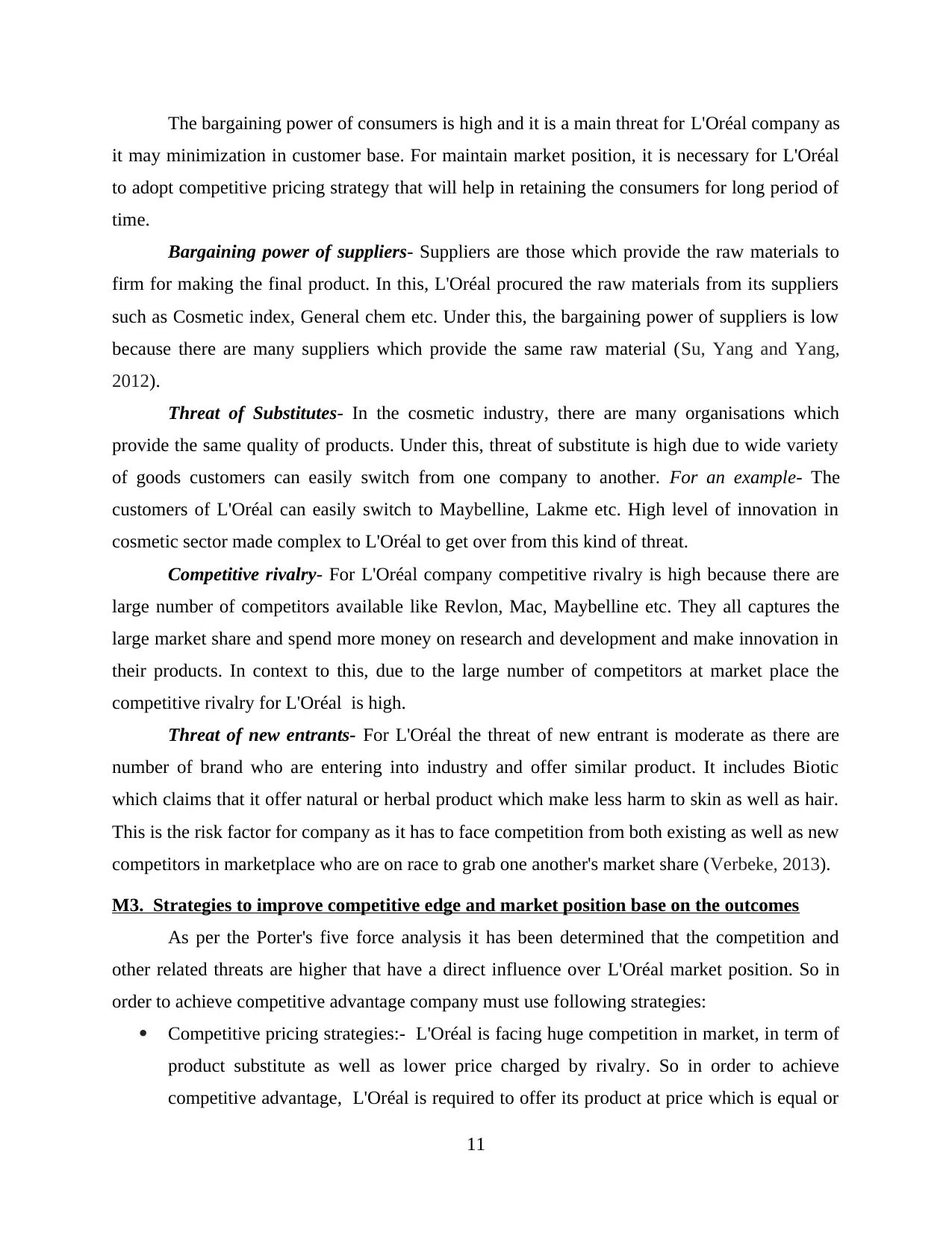
The bargaining power of consumers is high and it is a main threat for L'Oréal company as
it may minimization in customer base. For maintain market position, it is necessary for L'Oréal
to adopt competitive pricing strategy that will help in retaining the consumers for long period of
time.
Bargaining power of suppliers- Suppliers are those which provide the raw materials to
firm for making the final product. In this, L'Oréal procured the raw materials from its suppliers
such as Cosmetic index, General chem etc. Under this, the bargaining power of suppliers is low
because there are many suppliers which provide the same raw material (Su, Yang and Yang,
2012).
Threat of Substitutes- In the cosmetic industry, there are many organisations which
provide the same quality of products. Under this, threat of substitute is high due to wide variety
of goods customers can easily switch from one company to another. For an example- The
customers of L'Oréal can easily switch to Maybelline, Lakme etc. High level of innovation in
cosmetic sector made complex to L'Oréal to get over from this kind of threat.
Competitive rivalry- For L'Oréal company competitive rivalry is high because there are
large number of competitors available like Revlon, Mac, Maybelline etc. They all captures the
large market share and spend more money on research and development and make innovation in
their products. In context to this, due to the large number of competitors at market place the
competitive rivalry for L'Oréal is high.
Threat of new entrants- For L'Oréal the threat of new entrant is moderate as there are
number of brand who are entering into industry and offer similar product. It includes Biotic
which claims that it offer natural or herbal product which make less harm to skin as well as hair.
This is the risk factor for company as it has to face competition from both existing as well as new
competitors in marketplace who are on race to grab one another's market share (Verbeke, 2013).
M3. Strategies to improve competitive edge and market position base on the outcomes
As per the Porter's five force analysis it has been determined that the competition and
other related threats are higher that have a direct influence over L'Oréal market position. So in
order to achieve competitive advantage company must use following strategies:
Competitive pricing strategies:- L'Oréal is facing huge competition in market, in term of
product substitute as well as lower price charged by rivalry. So in order to achieve
competitive advantage, L'Oréal is required to offer its product at price which is equal or
11
it may minimization in customer base. For maintain market position, it is necessary for L'Oréal
to adopt competitive pricing strategy that will help in retaining the consumers for long period of
time.
Bargaining power of suppliers- Suppliers are those which provide the raw materials to
firm for making the final product. In this, L'Oréal procured the raw materials from its suppliers
such as Cosmetic index, General chem etc. Under this, the bargaining power of suppliers is low
because there are many suppliers which provide the same raw material (Su, Yang and Yang,
2012).
Threat of Substitutes- In the cosmetic industry, there are many organisations which
provide the same quality of products. Under this, threat of substitute is high due to wide variety
of goods customers can easily switch from one company to another. For an example- The
customers of L'Oréal can easily switch to Maybelline, Lakme etc. High level of innovation in
cosmetic sector made complex to L'Oréal to get over from this kind of threat.
Competitive rivalry- For L'Oréal company competitive rivalry is high because there are
large number of competitors available like Revlon, Mac, Maybelline etc. They all captures the
large market share and spend more money on research and development and make innovation in
their products. In context to this, due to the large number of competitors at market place the
competitive rivalry for L'Oréal is high.
Threat of new entrants- For L'Oréal the threat of new entrant is moderate as there are
number of brand who are entering into industry and offer similar product. It includes Biotic
which claims that it offer natural or herbal product which make less harm to skin as well as hair.
This is the risk factor for company as it has to face competition from both existing as well as new
competitors in marketplace who are on race to grab one another's market share (Verbeke, 2013).
M3. Strategies to improve competitive edge and market position base on the outcomes
As per the Porter's five force analysis it has been determined that the competition and
other related threats are higher that have a direct influence over L'Oréal market position. So in
order to achieve competitive advantage company must use following strategies:
Competitive pricing strategies:- L'Oréal is facing huge competition in market, in term of
product substitute as well as lower price charged by rivalry. So in order to achieve
competitive advantage, L'Oréal is required to offer its product at price which is equal or
11
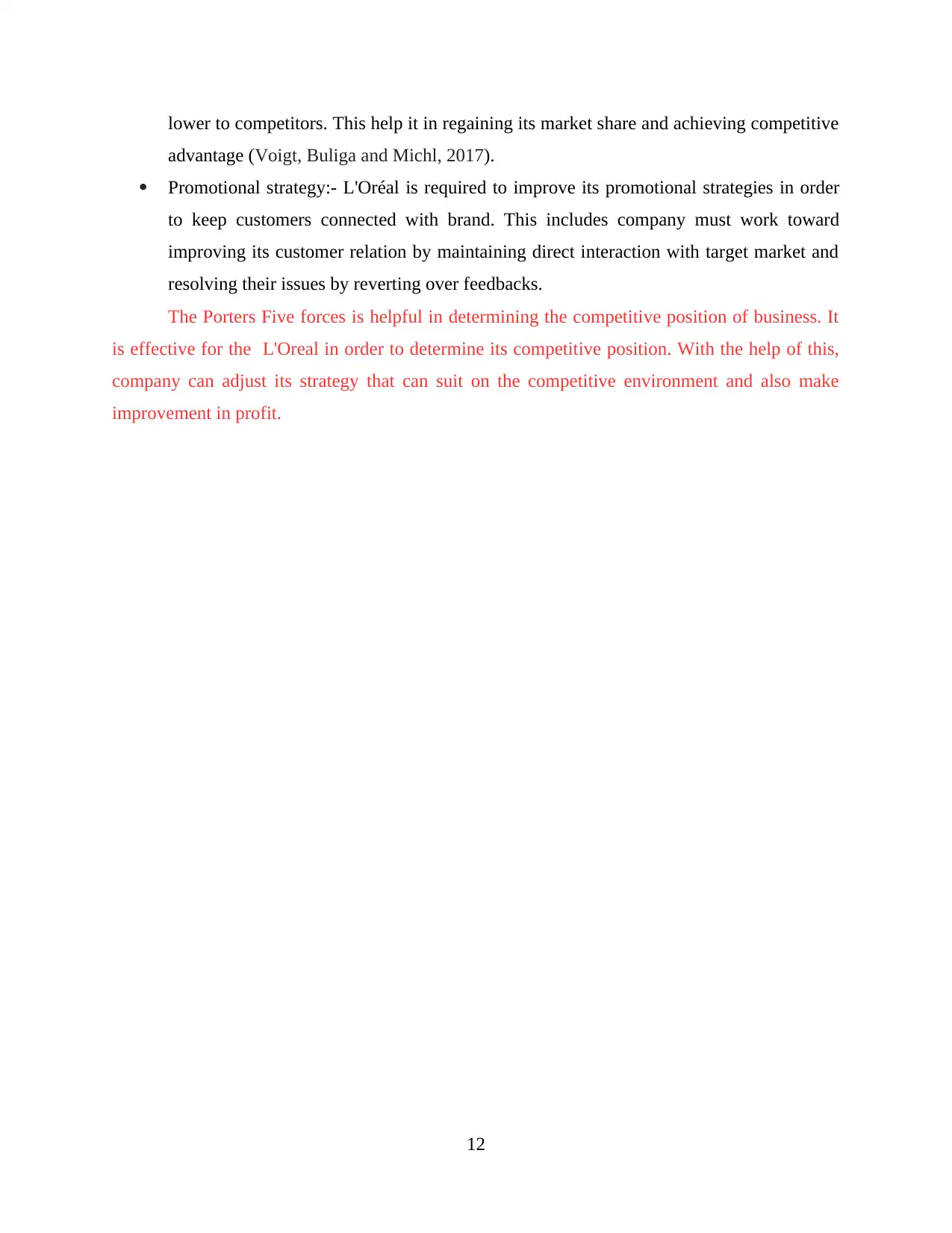
lower to competitors. This help it in regaining its market share and achieving competitive
advantage (Voigt, Buliga and Michl, 2017).
Promotional strategy:- L'Oréal is required to improve its promotional strategies in order
to keep customers connected with brand. This includes company must work toward
improving its customer relation by maintaining direct interaction with target market and
resolving their issues by reverting over feedbacks.
The Porters Five forces is helpful in determining the competitive position of business. It
is effective for the L'Oreal in order to determine its competitive position. With the help of this,
company can adjust its strategy that can suit on the competitive environment and also make
improvement in profit.
12
advantage (Voigt, Buliga and Michl, 2017).
Promotional strategy:- L'Oréal is required to improve its promotional strategies in order
to keep customers connected with brand. This includes company must work toward
improving its customer relation by maintaining direct interaction with target market and
resolving their issues by reverting over feedbacks.
The Porters Five forces is helpful in determining the competitive position of business. It
is effective for the L'Oreal in order to determine its competitive position. With the help of this,
company can adjust its strategy that can suit on the competitive environment and also make
improvement in profit.
12
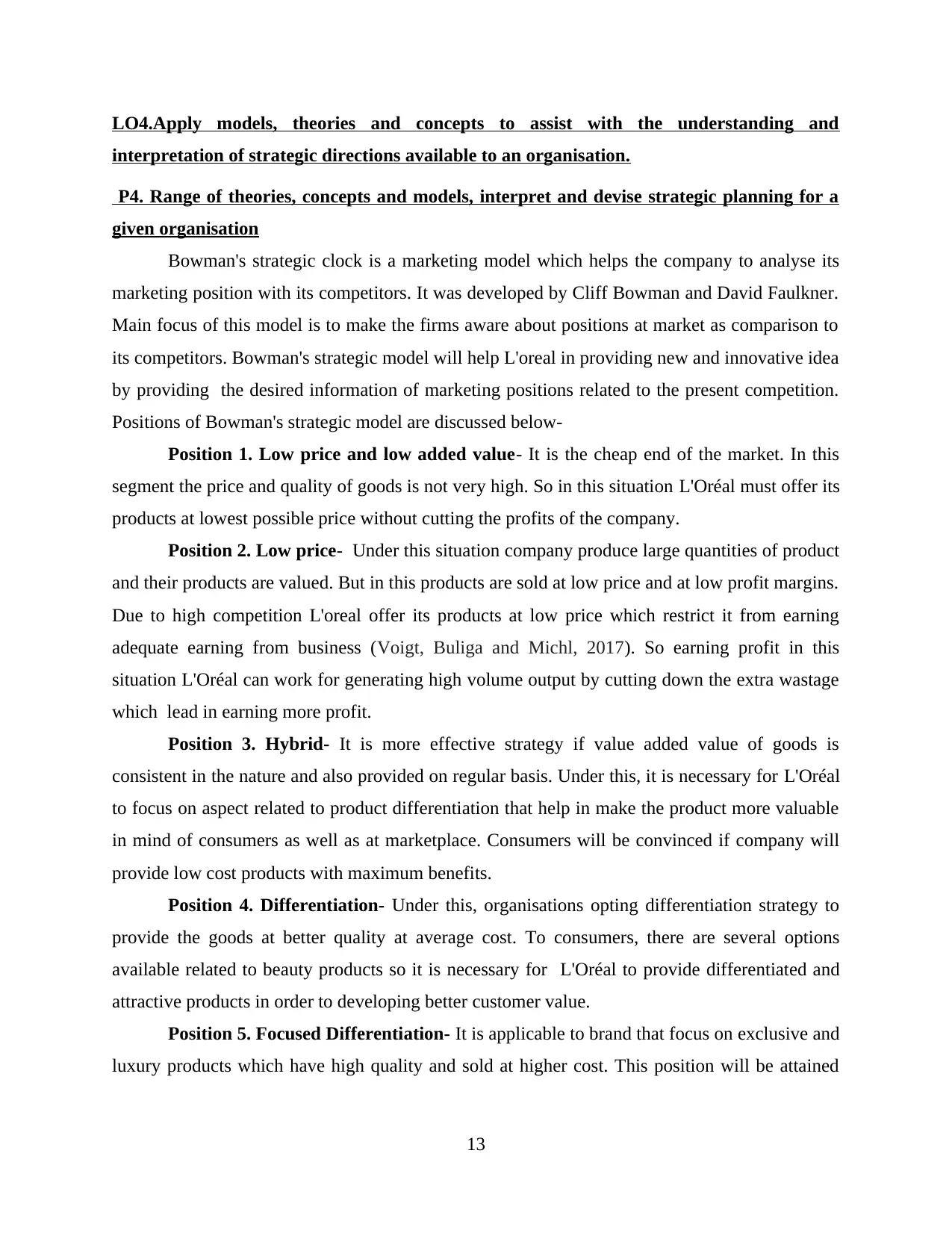
LO4.Apply models, theories and concepts to assist with the understanding and
interpretation of strategic directions available to an organisation.
P4. Range of theories, concepts and models, interpret and devise strategic planning for a
given organisation
Bowman's strategic clock is a marketing model which helps the company to analyse its
marketing position with its competitors. It was developed by Cliff Bowman and David Faulkner.
Main focus of this model is to make the firms aware about positions at market as comparison to
its competitors. Bowman's strategic model will help L'oreal in providing new and innovative idea
by providing the desired information of marketing positions related to the present competition.
Positions of Bowman's strategic model are discussed below-
Position 1. Low price and low added value- It is the cheap end of the market. In this
segment the price and quality of goods is not very high. So in this situation L'Oréal must offer its
products at lowest possible price without cutting the profits of the company.
Position 2. Low price- Under this situation company produce large quantities of product
and their products are valued. But in this products are sold at low price and at low profit margins.
Due to high competition L'oreal offer its products at low price which restrict it from earning
adequate earning from business (Voigt, Buliga and Michl, 2017). So earning profit in this
situation L'Oréal can work for generating high volume output by cutting down the extra wastage
which lead in earning more profit.
Position 3. Hybrid- It is more effective strategy if value added value of goods is
consistent in the nature and also provided on regular basis. Under this, it is necessary for L'Oréal
to focus on aspect related to product differentiation that help in make the product more valuable
in mind of consumers as well as at marketplace. Consumers will be convinced if company will
provide low cost products with maximum benefits.
Position 4. Differentiation- Under this, organisations opting differentiation strategy to
provide the goods at better quality at average cost. To consumers, there are several options
available related to beauty products so it is necessary for L'Oréal to provide differentiated and
attractive products in order to developing better customer value.
Position 5. Focused Differentiation- It is applicable to brand that focus on exclusive and
luxury products which have high quality and sold at higher cost. This position will be attained
13
interpretation of strategic directions available to an organisation.
P4. Range of theories, concepts and models, interpret and devise strategic planning for a
given organisation
Bowman's strategic clock is a marketing model which helps the company to analyse its
marketing position with its competitors. It was developed by Cliff Bowman and David Faulkner.
Main focus of this model is to make the firms aware about positions at market as comparison to
its competitors. Bowman's strategic model will help L'oreal in providing new and innovative idea
by providing the desired information of marketing positions related to the present competition.
Positions of Bowman's strategic model are discussed below-
Position 1. Low price and low added value- It is the cheap end of the market. In this
segment the price and quality of goods is not very high. So in this situation L'Oréal must offer its
products at lowest possible price without cutting the profits of the company.
Position 2. Low price- Under this situation company produce large quantities of product
and their products are valued. But in this products are sold at low price and at low profit margins.
Due to high competition L'oreal offer its products at low price which restrict it from earning
adequate earning from business (Voigt, Buliga and Michl, 2017). So earning profit in this
situation L'Oréal can work for generating high volume output by cutting down the extra wastage
which lead in earning more profit.
Position 3. Hybrid- It is more effective strategy if value added value of goods is
consistent in the nature and also provided on regular basis. Under this, it is necessary for L'Oréal
to focus on aspect related to product differentiation that help in make the product more valuable
in mind of consumers as well as at marketplace. Consumers will be convinced if company will
provide low cost products with maximum benefits.
Position 4. Differentiation- Under this, organisations opting differentiation strategy to
provide the goods at better quality at average cost. To consumers, there are several options
available related to beauty products so it is necessary for L'Oréal to provide differentiated and
attractive products in order to developing better customer value.
Position 5. Focused Differentiation- It is applicable to brand that focus on exclusive and
luxury products which have high quality and sold at higher cost. This position will be attained
13
Secure Best Marks with AI Grader
Need help grading? Try our AI Grader for instant feedback on your assignments.
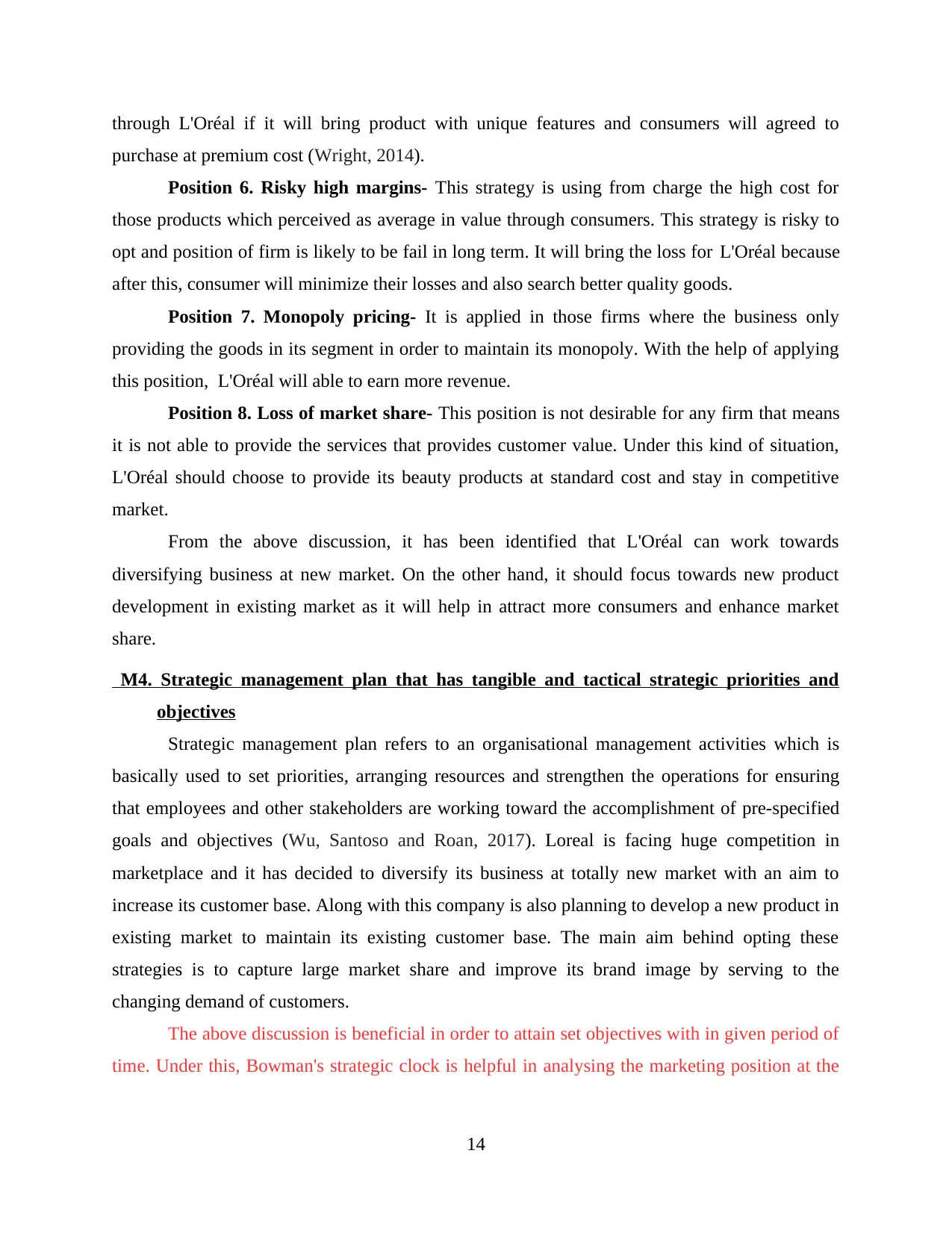
through L'Oréal if it will bring product with unique features and consumers will agreed to
purchase at premium cost (Wright, 2014).
Position 6. Risky high margins- This strategy is using from charge the high cost for
those products which perceived as average in value through consumers. This strategy is risky to
opt and position of firm is likely to be fail in long term. It will bring the loss for L'Oréal because
after this, consumer will minimize their losses and also search better quality goods.
Position 7. Monopoly pricing- It is applied in those firms where the business only
providing the goods in its segment in order to maintain its monopoly. With the help of applying
this position, L'Oréal will able to earn more revenue.
Position 8. Loss of market share- This position is not desirable for any firm that means
it is not able to provide the services that provides customer value. Under this kind of situation,
L'Oréal should choose to provide its beauty products at standard cost and stay in competitive
market.
From the above discussion, it has been identified that L'Oréal can work towards
diversifying business at new market. On the other hand, it should focus towards new product
development in existing market as it will help in attract more consumers and enhance market
share.
M4. Strategic management plan that has tangible and tactical strategic priorities and
objectives
Strategic management plan refers to an organisational management activities which is
basically used to set priorities, arranging resources and strengthen the operations for ensuring
that employees and other stakeholders are working toward the accomplishment of pre-specified
goals and objectives (Wu, Santoso and Roan, 2017). Loreal is facing huge competition in
marketplace and it has decided to diversify its business at totally new market with an aim to
increase its customer base. Along with this company is also planning to develop a new product in
existing market to maintain its existing customer base. The main aim behind opting these
strategies is to capture large market share and improve its brand image by serving to the
changing demand of customers.
The above discussion is beneficial in order to attain set objectives with in given period of
time. Under this, Bowman's strategic clock is helpful in analysing the marketing position at the
14
purchase at premium cost (Wright, 2014).
Position 6. Risky high margins- This strategy is using from charge the high cost for
those products which perceived as average in value through consumers. This strategy is risky to
opt and position of firm is likely to be fail in long term. It will bring the loss for L'Oréal because
after this, consumer will minimize their losses and also search better quality goods.
Position 7. Monopoly pricing- It is applied in those firms where the business only
providing the goods in its segment in order to maintain its monopoly. With the help of applying
this position, L'Oréal will able to earn more revenue.
Position 8. Loss of market share- This position is not desirable for any firm that means
it is not able to provide the services that provides customer value. Under this kind of situation,
L'Oréal should choose to provide its beauty products at standard cost and stay in competitive
market.
From the above discussion, it has been identified that L'Oréal can work towards
diversifying business at new market. On the other hand, it should focus towards new product
development in existing market as it will help in attract more consumers and enhance market
share.
M4. Strategic management plan that has tangible and tactical strategic priorities and
objectives
Strategic management plan refers to an organisational management activities which is
basically used to set priorities, arranging resources and strengthen the operations for ensuring
that employees and other stakeholders are working toward the accomplishment of pre-specified
goals and objectives (Wu, Santoso and Roan, 2017). Loreal is facing huge competition in
marketplace and it has decided to diversify its business at totally new market with an aim to
increase its customer base. Along with this company is also planning to develop a new product in
existing market to maintain its existing customer base. The main aim behind opting these
strategies is to capture large market share and improve its brand image by serving to the
changing demand of customers.
The above discussion is beneficial in order to attain set objectives with in given period of
time. Under this, Bowman's strategic clock is helpful in analysing the marketing position at the
14
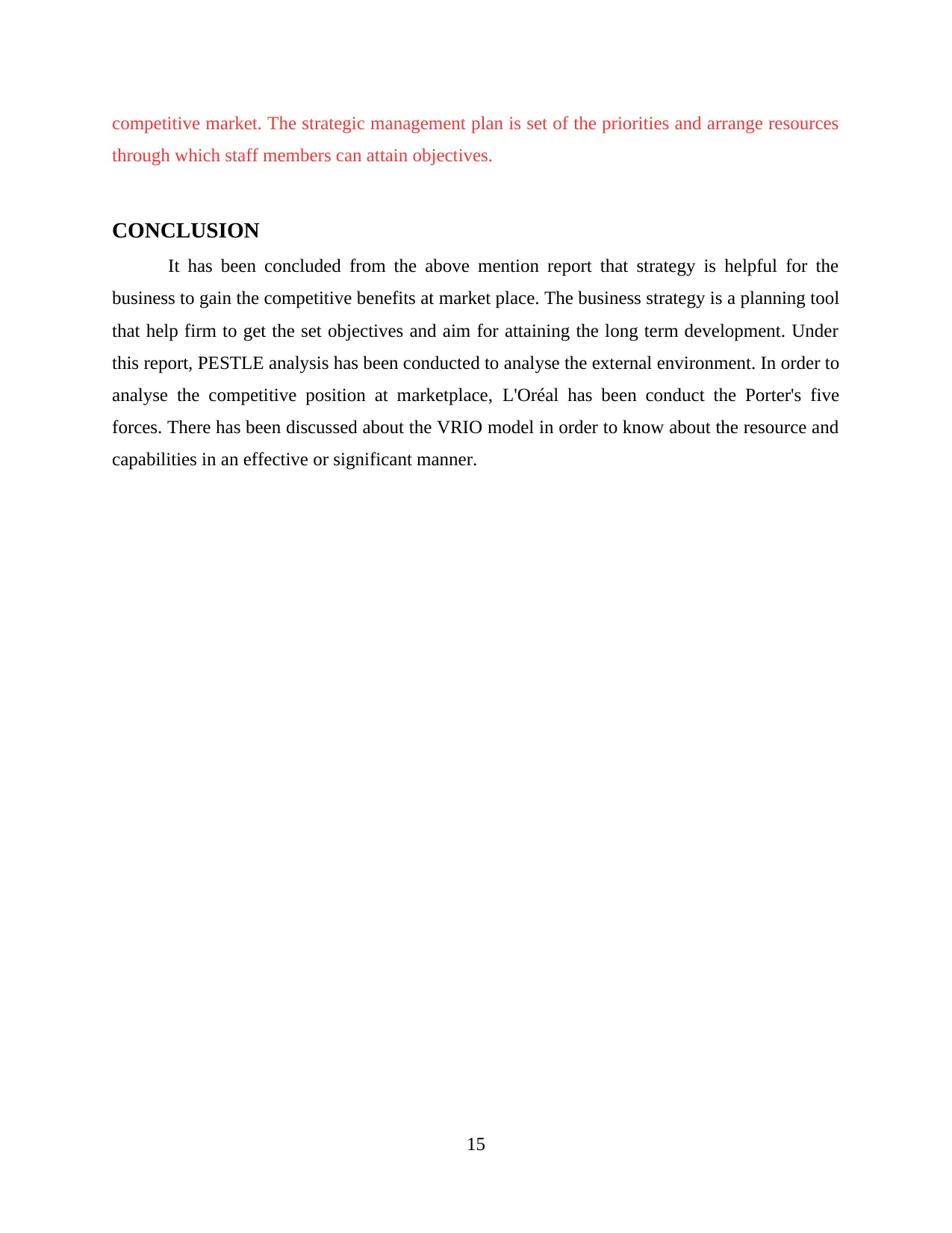
competitive market. The strategic management plan is set of the priorities and arrange resources
through which staff members can attain objectives.
CONCLUSION
It has been concluded from the above mention report that strategy is helpful for the
business to gain the competitive benefits at market place. The business strategy is a planning tool
that help firm to get the set objectives and aim for attaining the long term development. Under
this report, PESTLE analysis has been conducted to analyse the external environment. In order to
analyse the competitive position at marketplace, L'Oréal has been conduct the Porter's five
forces. There has been discussed about the VRIO model in order to know about the resource and
capabilities in an effective or significant manner.
15
through which staff members can attain objectives.
CONCLUSION
It has been concluded from the above mention report that strategy is helpful for the
business to gain the competitive benefits at market place. The business strategy is a planning tool
that help firm to get the set objectives and aim for attaining the long term development. Under
this report, PESTLE analysis has been conducted to analyse the external environment. In order to
analyse the competitive position at marketplace, L'Oréal has been conduct the Porter's five
forces. There has been discussed about the VRIO model in order to know about the resource and
capabilities in an effective or significant manner.
15

REFERENCES
Books & Journals
Bharadwaj, A. and et. al., 2013. Digital business strategy: toward a next generation of insights.
MIS quarterly, pp.471-482.
Blackburn, R. A., Hart, M. and Wainwright, T., 2013. Small business performance: business,
strategy and owner-manager characteristics. Journal of small business and enterprise
development. 20(1). pp.8-27.
Cepiku, D. and Bonomi Savignon, A., 2012. Governing cutback management: is there a global
strategy for public administrations?. International Journal of Public Sector
Management. 25(6/7). pp.428-436.
Hill, D. C. and Seabrook, K. A., 2013. Safety & sustainability: Understanding the business
value. Professional Safety. 58(6). p.81.
Hoque, K., 2013. Human resource management in the hotel industry: Strategy, innovation and
performance. Routledge.
Iacob, M. E., Quartel, D. and Jonkers, H., 2012, September. Capturing business strategy and
value in enterprise architecture to support portfolio valuation. In 2012 IEEE 16th
International Enterprise Distributed Object Computing Conference (pp. 11-20). IEEE.
Pasquinelli, C., 2014. Branding as urban collective strategy-making: The formation of
NewcastleGateshead’s organisational identity. Urban Studies. 51(4). pp.727-743.
Peng, M. W., 2017. Cultures, institutions, and strategic choices: Toward an institutional
perspective on business strategy.The Blackwell handbook of cross‐cultural management,
pp.52-66.
Scholes, M. S., 2015. Taxes and business strategy. Prentice Hall.
Schrader, C., Freimann, J. and Seuring, S., 2012. Business strategy at the base of the pyramid.
Business Strategy and the environment. 21(5). pp.281-298.
Spender, J. C., 2014. Business strategy: Managing uncertainty, opportunity, and enterprise.
Oxford University Press.
Su, Z., Yang, D. and Yang, J., 2012. The match between efficiency/flexibility strategy and
organisational culture. International Journal of Production Research. 50(19). pp.5317-
5329.
Verbeke, A., 2013. International business strategy. Cambridge University Press.
Voigt, K. I., Buliga, O. and Michl, K., 2017. Business Model Pioneers. Management for
Professionals.
Wright, S., 2014. Competitive intelligence, analysis and strategy: Creating organisational
agility. Routledge.
Wu, J. Z., Santoso, C. H. and Roan, J., 2017. Key factors for truly sustainable supply chain
management: An investigation of the coal industry in Indonesia. The International
Journal of Logistics Management.28(4). pp.1196-1217.
16
Books & Journals
Bharadwaj, A. and et. al., 2013. Digital business strategy: toward a next generation of insights.
MIS quarterly, pp.471-482.
Blackburn, R. A., Hart, M. and Wainwright, T., 2013. Small business performance: business,
strategy and owner-manager characteristics. Journal of small business and enterprise
development. 20(1). pp.8-27.
Cepiku, D. and Bonomi Savignon, A., 2012. Governing cutback management: is there a global
strategy for public administrations?. International Journal of Public Sector
Management. 25(6/7). pp.428-436.
Hill, D. C. and Seabrook, K. A., 2013. Safety & sustainability: Understanding the business
value. Professional Safety. 58(6). p.81.
Hoque, K., 2013. Human resource management in the hotel industry: Strategy, innovation and
performance. Routledge.
Iacob, M. E., Quartel, D. and Jonkers, H., 2012, September. Capturing business strategy and
value in enterprise architecture to support portfolio valuation. In 2012 IEEE 16th
International Enterprise Distributed Object Computing Conference (pp. 11-20). IEEE.
Pasquinelli, C., 2014. Branding as urban collective strategy-making: The formation of
NewcastleGateshead’s organisational identity. Urban Studies. 51(4). pp.727-743.
Peng, M. W., 2017. Cultures, institutions, and strategic choices: Toward an institutional
perspective on business strategy.The Blackwell handbook of cross‐cultural management,
pp.52-66.
Scholes, M. S., 2015. Taxes and business strategy. Prentice Hall.
Schrader, C., Freimann, J. and Seuring, S., 2012. Business strategy at the base of the pyramid.
Business Strategy and the environment. 21(5). pp.281-298.
Spender, J. C., 2014. Business strategy: Managing uncertainty, opportunity, and enterprise.
Oxford University Press.
Su, Z., Yang, D. and Yang, J., 2012. The match between efficiency/flexibility strategy and
organisational culture. International Journal of Production Research. 50(19). pp.5317-
5329.
Verbeke, A., 2013. International business strategy. Cambridge University Press.
Voigt, K. I., Buliga, O. and Michl, K., 2017. Business Model Pioneers. Management for
Professionals.
Wright, S., 2014. Competitive intelligence, analysis and strategy: Creating organisational
agility. Routledge.
Wu, J. Z., Santoso, C. H. and Roan, J., 2017. Key factors for truly sustainable supply chain
management: An investigation of the coal industry in Indonesia. The International
Journal of Logistics Management.28(4). pp.1196-1217.
16
1 out of 19
Related Documents
Your All-in-One AI-Powered Toolkit for Academic Success.
+13062052269
info@desklib.com
Available 24*7 on WhatsApp / Email
![[object Object]](/_next/static/media/star-bottom.7253800d.svg)
Unlock your academic potential
© 2024 | Zucol Services PVT LTD | All rights reserved.





